Sometimes, it takes the world a moment to fully understand genius. This was clearly the case during the first Impressionist exhibition when, upon viewing Monet’s now iconic Impression, Sunrise, the humorist, critic and clearly something of a moron, Louis Leroy, scathingly and derisively wrote, “Wallpaper in its embryonic state is more finished than that seascape.” History, of course, being the greatest judge, holds Monet in awed reverence while Leroy’s name has faded into an anonymity that is most analogous to the “unfinished wallpaper” he once so unwittingly compared Monet’s painting to.

The Octo Finissimo has, since its first emergence in 2014, stunned the world repeatedly
with its muscular architecture and refined elegance. Its latest release in satin-polished
steel makes it one of the most coveted sports chic watches today (Image © Revolution)
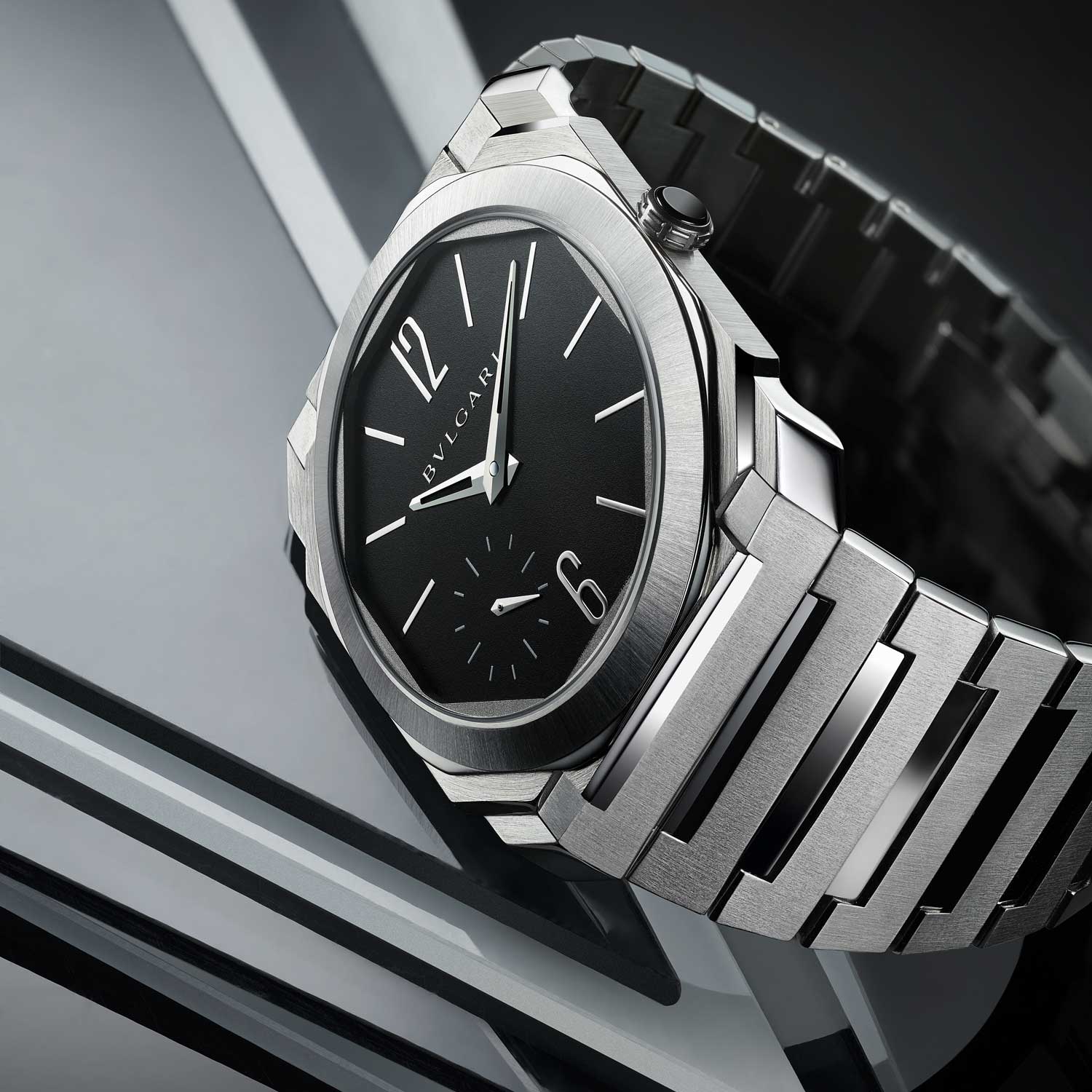
The new Octo Finissimo in satin polished steel
While the Bvlgari Octo Finissimo was instantly recognized by those of us who understood its deliciously brazen departure from the banal, formulaic repetition of yearly watch novelties whose mantra was “new dial/strap/hands but no change”, it took the rest of the world a few years to fully comprehend that this was more than a daring design, but a statement of in-house competences — in dial making, case making, movement making and bracelet making — so brilliantly and synergistically linked that to me, it is the single greatest watchmaking achievement in the last decade of modern horology. Further, the Octo Finissimo’s story not only in terms of record-setting technical achievement, but also its rise as a contemporary icon to truly rival the entrenched integrated bracelet, sports chic watches — Patek Philippe’s Nautilus and Audemars Piguet’s Royal Oak — is a statement of the inspired leadership of the true innovator that is Bvlgari’s CEO Jean-Christophe Babin. Babin, over his tenure as the CEO of the famed Roman jeweler, has innovated not just at the product level, not just at the brand level, not just at the communication level, but also at the exhibition level by staging, along with his sister brands Hublot and Zenith, the first-ever LVMH Group watch fair held in Dubai this January.

CEO of Bvlgari, Jean-Christophe Babin
Origins of a Horological Icon
But before we go into the history and milestones of the Octo Finissimo, let’s pause to examine the genesis of the integrated sports watch and the way in which Bvlgari is both spiritually aligned and yet a radical departure from its rivals. So, time was, if you were a Riviera Rake with the last name Agnelli or Rubirosa in that halcyon era between the ’50s and the ’70s, before the Côte d’Azur was overrun by oligarchs and priapically winged orange Lamborghinis that look like mobile fertility symbols, before the era of champagne bottle wars and when culture, taste and money still aligned, you had to dress in a certain way. And that was with a certain educated but nonchalant élan, a Cifonelli or Caraceni blazer worn or, better, cast over one shoulder like an old bathrobe as you hopped out of your Ferrari 250 SWB and carved your path through the trellises of connubial haut monde mademoiselles to the bar at the Hôtel du Cap. Now the watch on your wrist could hardly be something as pragmatic as a diver’s tool watch. No, what you needed to have, to casually check how many hours from sunset and that rendezvous with that Italian screen ingénue decamped incognito to a nearby villa, was an integrated bracelet, sports chic watch.
In the ’70s there were two models, the Royal Oak created in 1972 and the Nautilus in 1976. The man behind both these watches, and clearly an individual with a penchant for slim timepieces with faceted bezels that exhibited a dynamic tension between bold, muscular designs counterpointed by slim (some would even say lithe) profiles, was one Gérald Genta. When Genta eventually created his own eponymous brand, he would also design an octagonal watch with an eight-sided bezel. Cut to several decades later in 2000 when Bvlgari would purchase both Gérald Genta and Daniel Roth, at the time both owned by Singapore’s Tay family of The Hour Glass fame, and inherit a great deal of high-complication competences — two watch manufactures and the octagonal model that, while appealing, had not yet realized its full creative potential.
Indeed, it took a few years for Bvlgari’s team of Babin, Fabrizio Buonamassa and then-watchmaking head Guido Terreni to realize what Genta’s design truly could be. However, to achieve this, they had to undertake one of the most technically innovative and daring creative programs in the history of luxury watchmaking. The complexity came about because one of the key objectives with Bvlgari’s new Octo model, to be named the Octo Finissimo, was to create the world’s thinnest mechanical watch. Says Jean-Christophe Babin, “With respect to my competitors, movement innovation like this hadn’t really been achieved since the last real pioneering era of the late ’60s, when the industry was chasing the achievement of the first automatic chronograph with Heuer, Breitling and Hamilton pursuing the Caliber 11 and Zenith ultimately arriving at the groundbreaking El Primero.

Fabrizio Buonamassa, Director of Watch Design at Bulgari
For us, it was never the pursuit purely to have the world’s thinnest mechanical watch. Rather, the goal was to bring that same daring, innovation and finesse that has made us a leader in the ladies’ and jewelry sector to the world of men’s watches. It dawned on us that our advantage is that we are Italian. All our watches and their components are made in Switzerland but from a design perspective, as an Italian company, we are much more open than the Swiss. We draw inspiration from Italian architecture, from fashion, from cinema, from the automotive world and from the very landscape of our home city, Rome, which is so beautiful. We decided we wanted to express the two very Italian qualities of strength and elegance in a bold and groundbreaking manner.”
2014: Octo Finissimo Mechanical Hand-wound
Buonamassa, Bvlgari’s design director, explains, “The objective of thinness was not arrived at in isolation. After all, there are many brands that have been associated with ultra-thin watches, especially in the 20th century. The objective was to enhance this dynamic tension, this unique proposition between having a watch that was, when viewed straight on, very muscular and even aggressive, yet when you turned it on its side, it was really surprising in how thin it was. I wanted, as Jean-Christophe expressed, to bring something to watches that the world had never seen in terms of this proposition.”
But this objective of dynamic tension between bold and thin necessitated Bvlgari to push the technical envelope in every component of the Octo Finissimo. Says Babin, “The Octo Finissimo was only possible because we own our movement maker, dial maker, casemaker [and] bracelet maker, as it would be impossible to convince outside suppliers to make the effort we needed.”
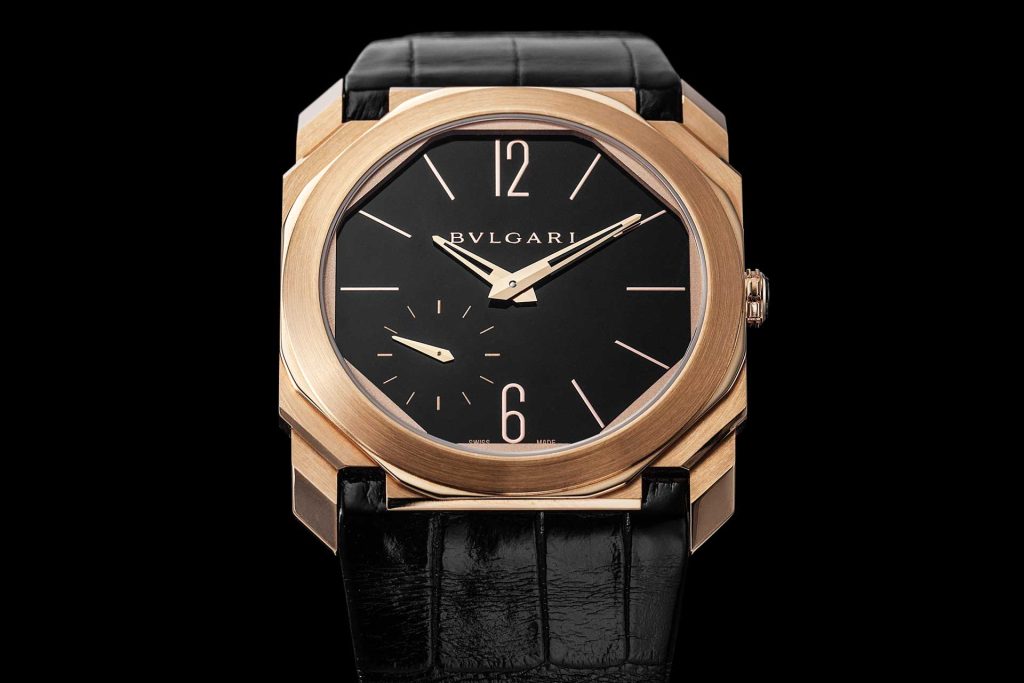
The Octo Finissimo Petite Seconds in rose gold, with hour markers that are galvanically grown and then transferred to the dial (©Revolution)
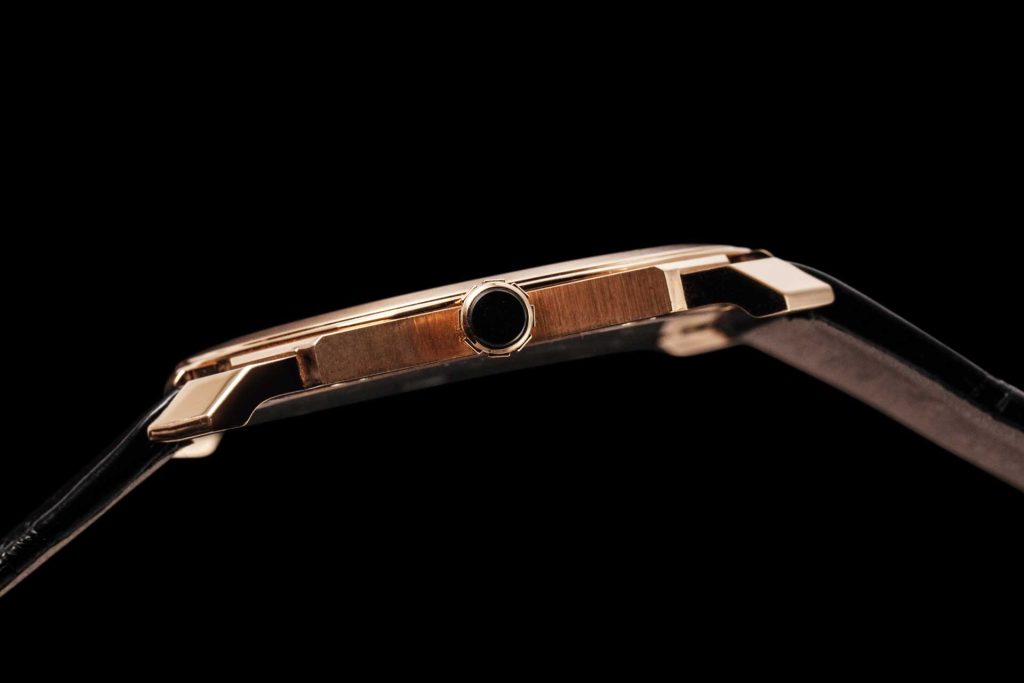
Side profile of the Octo Finissimo Petite Seconds in rose gold (©Revolution)
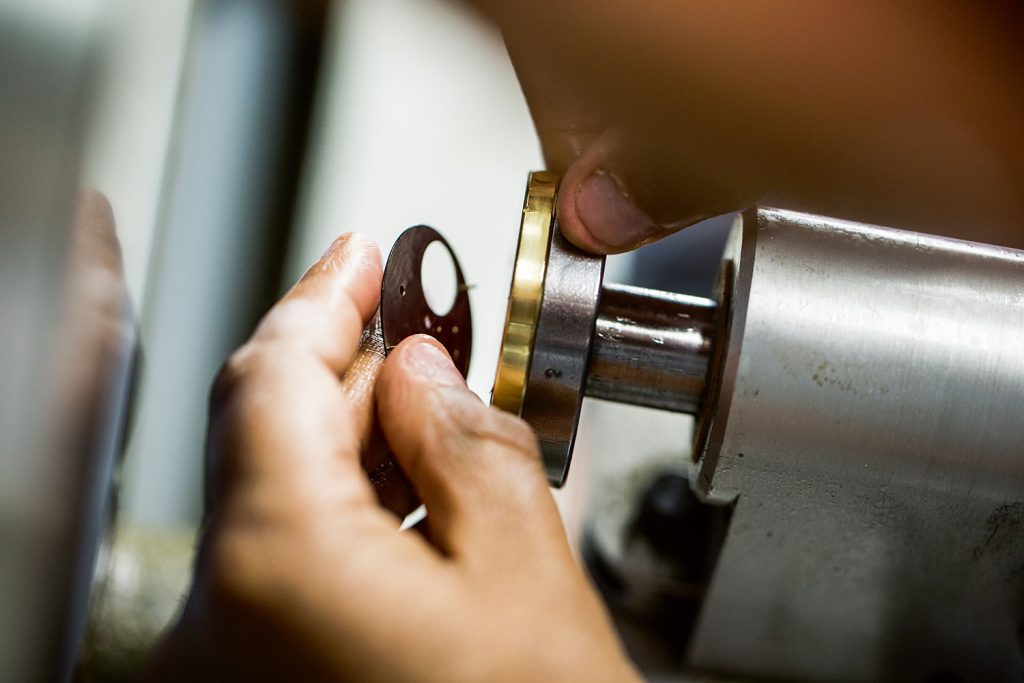
The dial of the Octo Finissimo measures a mere 0.2mm thin
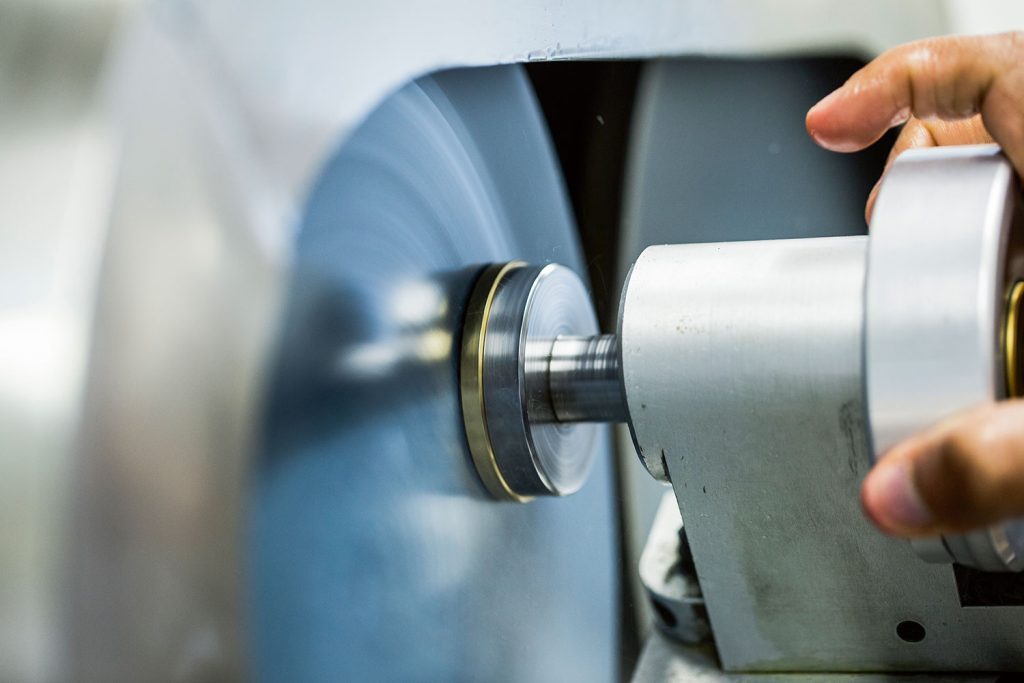
Each dial is finished by hand
What kind of effort are we talking about? For example, the entire dial of the Octo Finissimo is 0.2mm (0.3mm if a coat of lacquer is applied) which makes it thinner than a single index on the majority of other watches. In order for this to be achieved, the indexes and even the “Bvlgari” signature have to be galvanically grown and transferred over to the dial, almost as if they were stickers. In the instance of the Octo Finissimo, it is just the seconds track in the subdial that is printed. The very first Octo Finissimo was a manual wind (now replaced by a micro-rotor, automatic-winding model) with a BVL 128 movement that was 2.23mm and a final watch that was 5.15mm in total thickness. In order to achieve this, even the way in which the watch was assembled had to be completely rethought.
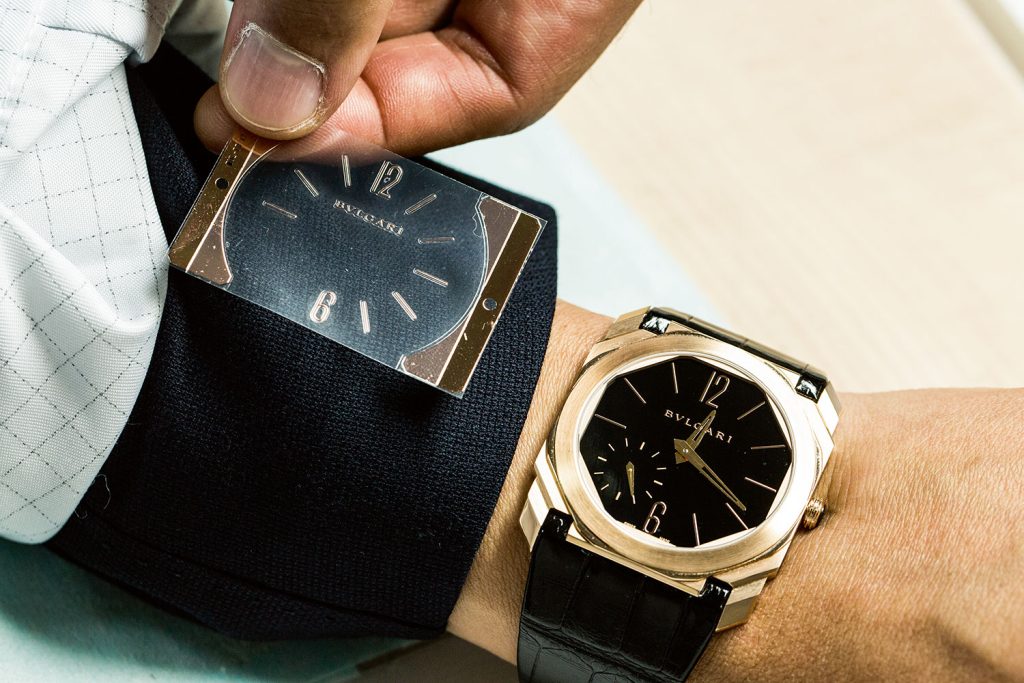
The plate on which the maison’s logo and hour indexes are positioned, with the actual Octo Finissimo Petite Seconds (Image © Revolution)
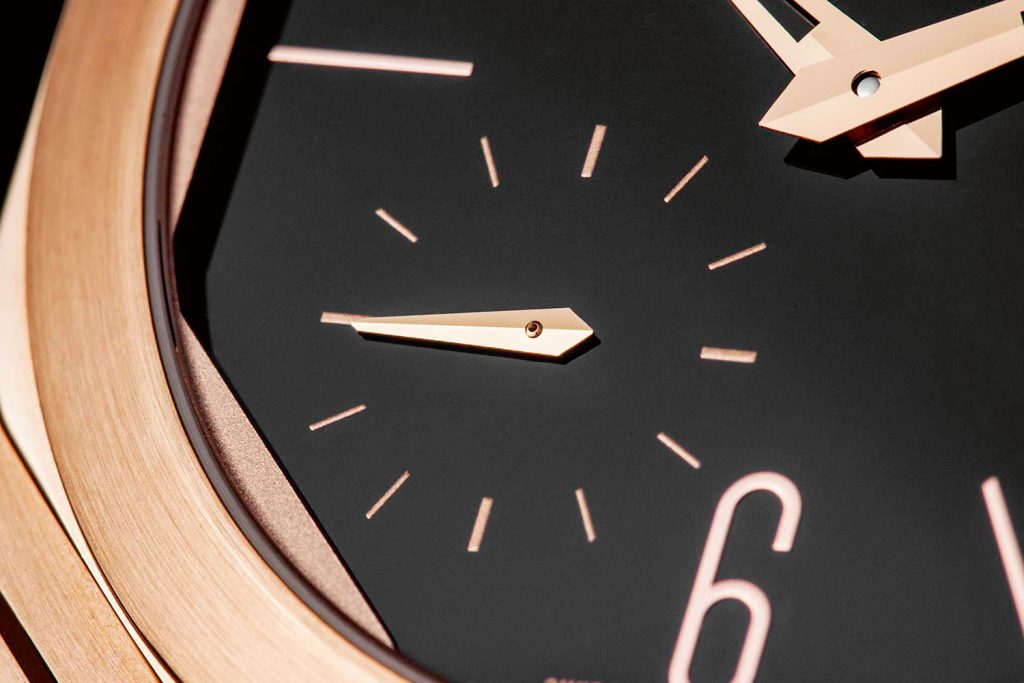
The small seconds counteris printed on the dial, because the height clearance needed for the seconds hand would not fit under the sapphire crystal otherwise (Image © Revolution)
Says Buonamassa, “Of course we wanted a sapphire back to showcase the beauty of our in-house caliber with its beautiful ‘full bridge’ architecture. However, to conserve space, the sapphire back is integrated into the case, basically pre-fitted into the monobloc case. Next, the movement is placed into the case, [then] the dial and hands are added and finally the bezel and sapphire are placed on top. It is the bezel that seals the watch.” Each bezel features eight hollow threaded posts that are inserted through the case and fixed at the back of the watch with special fasteners that look like five-sided nuts. I particularly like that because they are not slotted, they are never out of alignment as you see on other watches that are fastened in the back in this way.
I should also pause to reflect on the beauty and pragmatism of Bvlgari’s movement design. First, the movement is as Buonamassa called it a “full bridge” design, which means each part of the gear train is retained by a different bridge, making it much more practical to service. Further, the balance wheel sits on a bridge fixed on both sides rather than a cock which is only fixed on one side. This provides better stability and shock resistance.
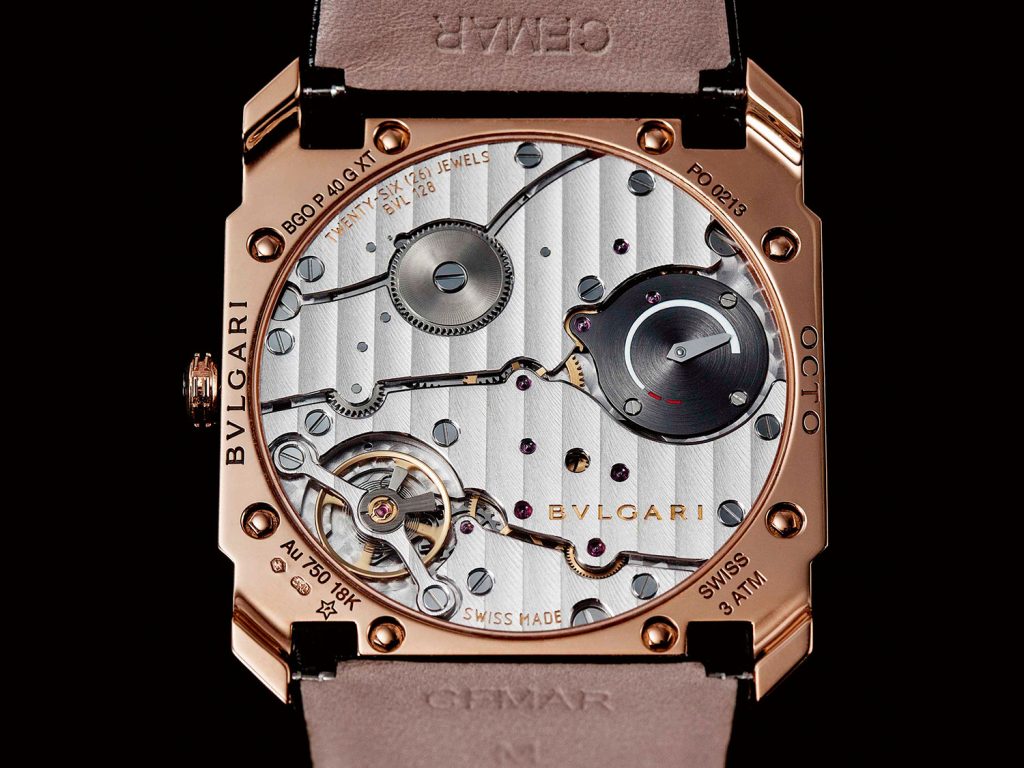
The escapement of the BVL 128 is supported with a balance bridge that’s screwed down on both
sides, rather than a balance cock, which improves the ultra-thin movement’s shock resistance; the barrel bridge doubles as a power reserve display (Image © Revolution)
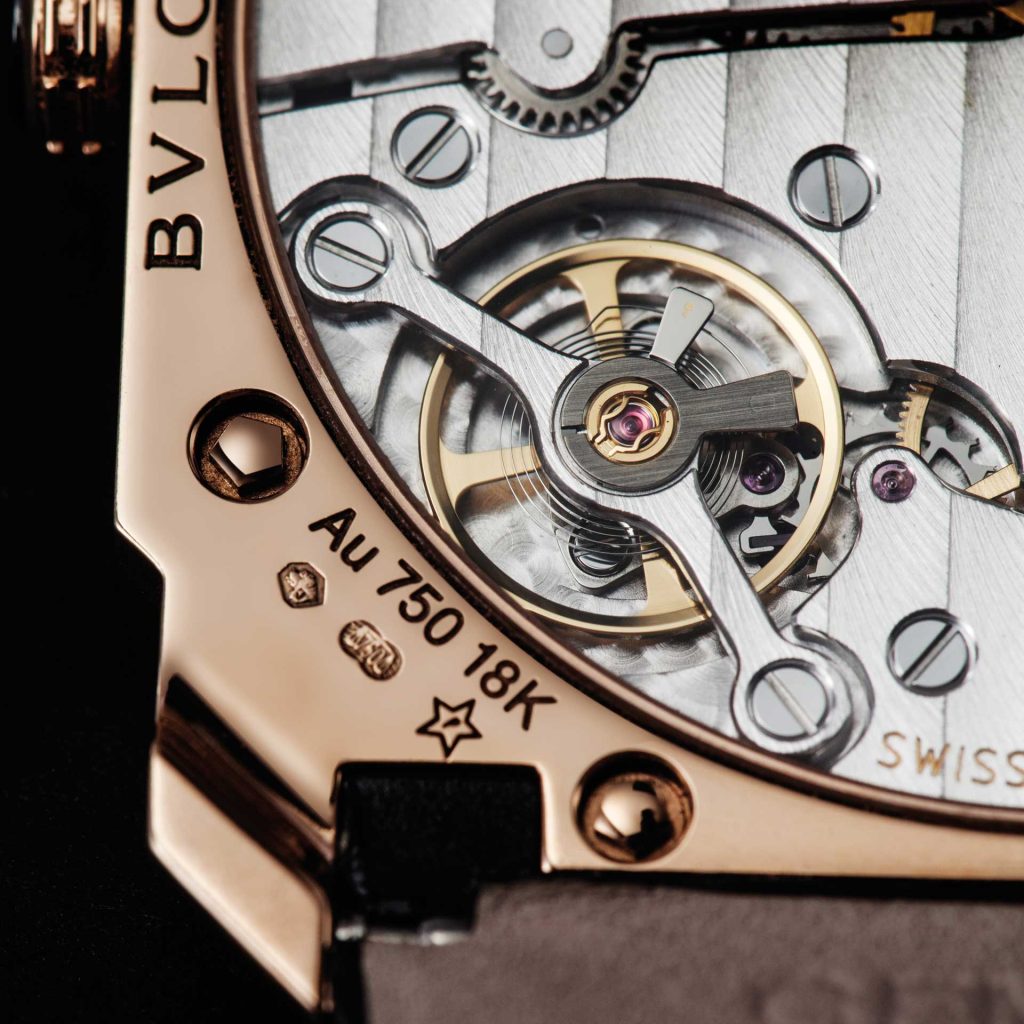
The escapement of the BVL 128 is supported with a balance bridge that’s screwed down on both
sides, rather than a balance cock, which improves the ultra-thin movement’s shock resistance (Image © Revolution)
I recall the moment I tried on the Octo Finissimo manual-wind watch in 2014, thinking to myself what an absolute revelation it was. First, because in a very different way than Richard Mille, which is all about expressing the world of motorsport and aerospace technology, Bvlgari had created the first classic chic timepiece that was unabashedly forward-looking rather than reaching inexorably into its past. And while there is nothing wrong with watches that are almost exact extensions of models created a half century ago — indeed that is precisely why people love the Audemars Piguet Royal Oak Extra-Thin 15202 or Omega Speedmaster Moonwatch Professional — here we had for the first time in the sports chic genre something that moved the game forward aesthetically and technically by light years. The Octo Finissimo in many ways reminds me of the cars designed by my friend, Ferrari creative director Flavio Manzoni, in which he intentionally avoids overtly referencing the past and wants to create the aesthetic heritage of the future by taking massive and fearless leaps forward.
2016: Octo Finissimo Minute Repeater
However, in 2016, another model in the Octo Finissimo family had collectors, journalists and even the most jaded retailer’s eyes moist with emotion and our hearts filled with unbridled avarice, because Bvlgari had just created the coolest minute repeater in modern watchmaking and one of the real defining watches of the new millennium. Says Jean-Christophe Babin, “While it is unusual [that] you refer to this complication as cool, somehow it is very appropriate. That’s because minute repeaters, which are considered to be the pinnacle of watchmaking art, are extraordinary creations but they are very rarely considered to be cool. That’s because they are generally classically styled watches. In comparison, the Octo Finissimo Minute Repeater, which set the record as the world’s thinnest minute repeater, was created intentionally as the ultimate stealthy complication. It was made in grade 5 titanium, with just the smallest details that showed the difference between this and a simpler three-hand watch. Why? Because we knew the world had changed and we felt there was a whole new generation of connoisseurs that liked to live in a more relaxed, discrete and cool way. That’s the reason for the matte-colored titanium and the way the pusher for the repeater is so subtly integrated into the side of the case.
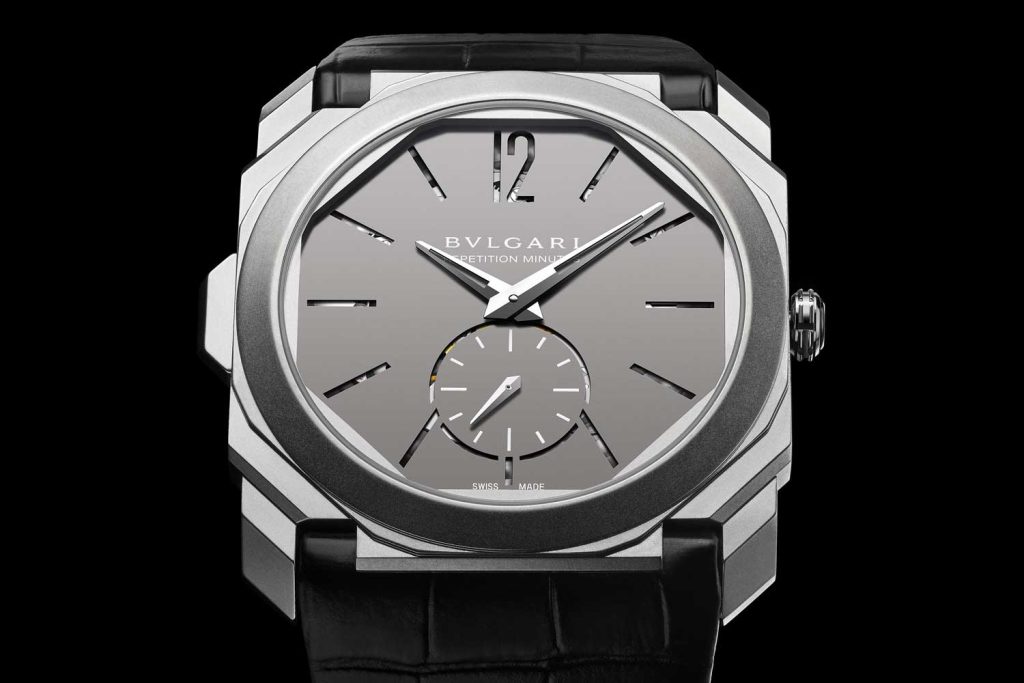
The 2016 Bvlgari Octo Finissimo Titanium Minute Repeater
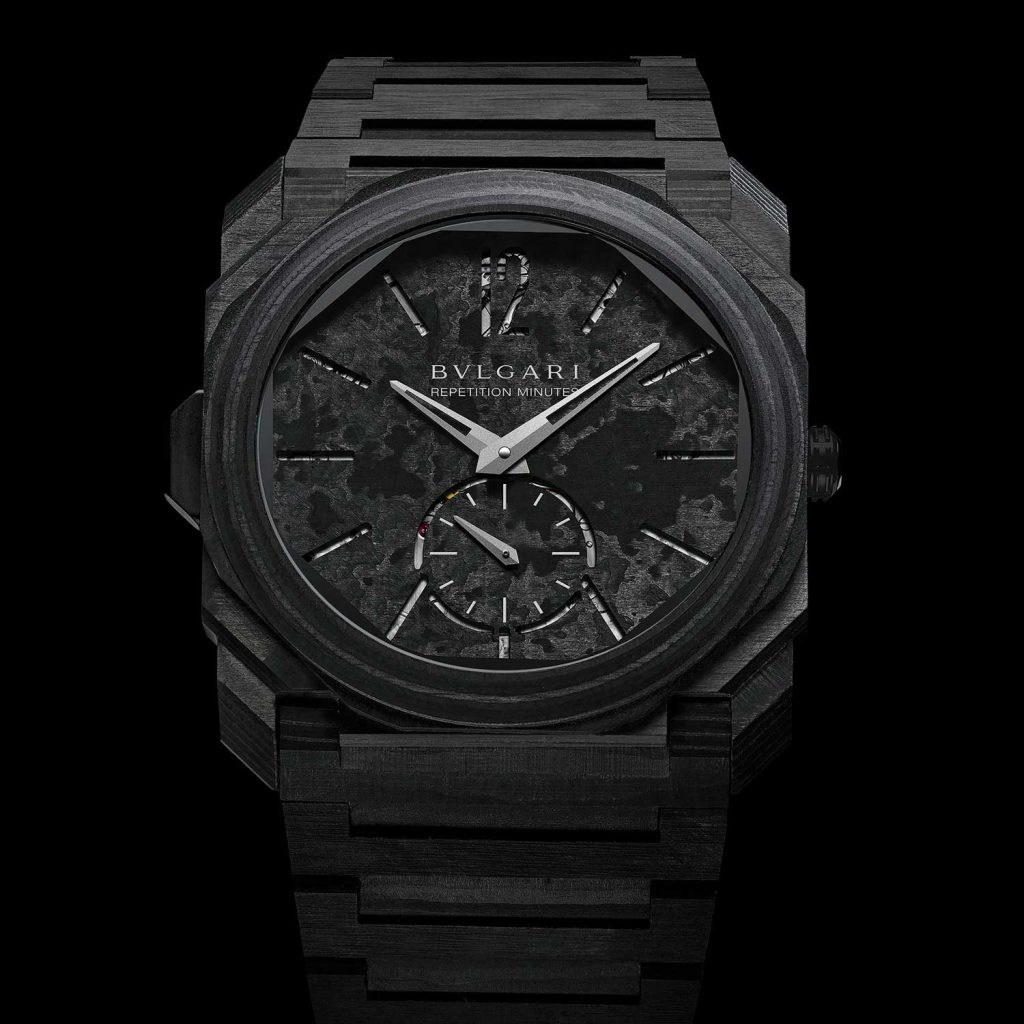
The 2018 Octo Finissimo Minute Repeater Carbon in carbon thin-ply (CTP)
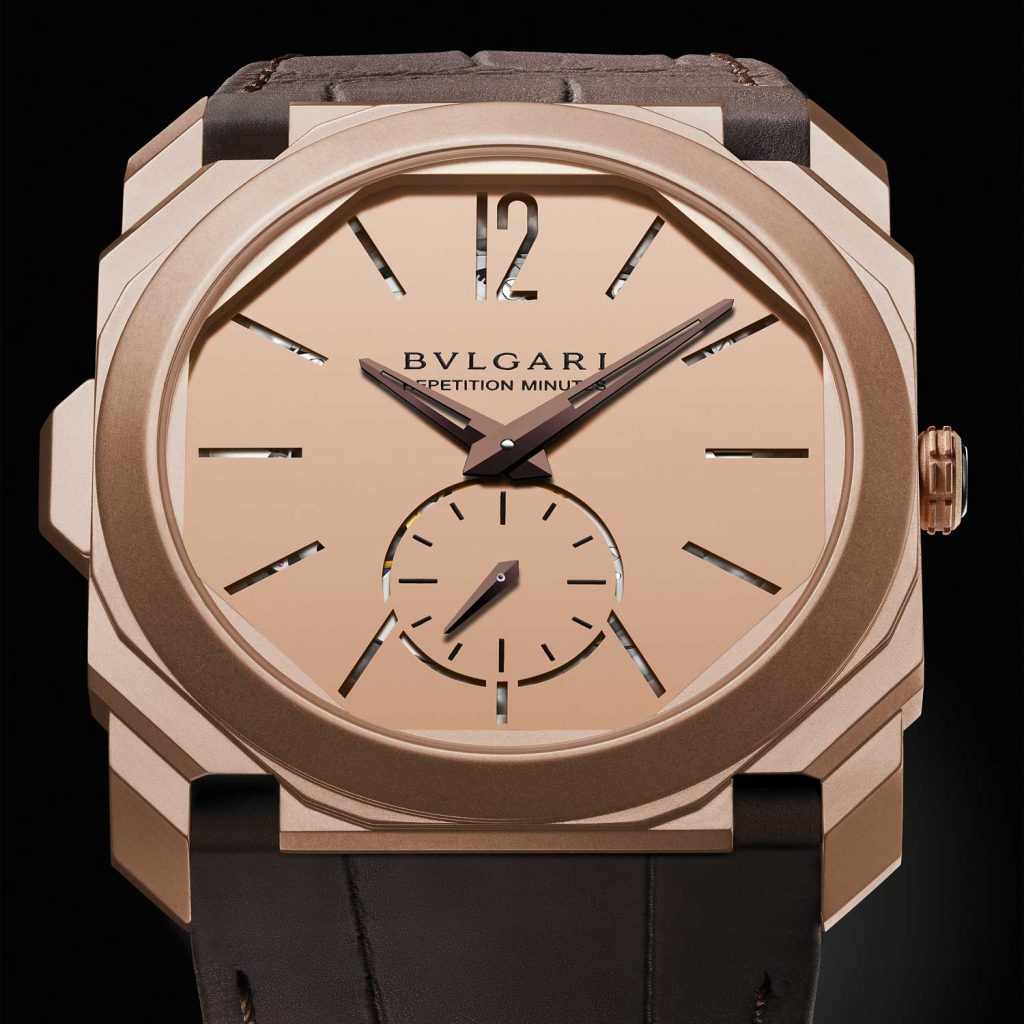
The Octo Finissimo Minute Repeater in sandblasted 18K rose gold, introduced earlier in 2020 in Dubai
“We could see the emergence of these clients because we received them at our Bvlgari hotels. They perfectly fit this profile. They had amazing style and didn’t mind spending on the best, but they didn’t want to appear stuffy. And they didn’t want a minute repeater that sat in a safe, but something they could wear all the time without really being noticed in a showy way. We created the [Octo Finissimo] minute repeater for them. However, we also knew that if we were going to create this minute repeater, even if it set a record for its thinness, we had to ensure it sounded amazing. Most minute repeaters employ a voluminous case to help the quality and volume of their sound. We didn’t have that luxury, so our team came up with an amazing technical solution, which was to skeletonize the indexes on the titanium dial to allow sound to travel through the front of the watch. The result was that we gained in volume as if we had enlarged the dimensions of the case, even though we didn’t. The great thing about this is that people initially took these indexes to be a stylistic flourish, which of course they are, but they also had a functional rationale. At Bvlgari, we pursue technical innovation, but always as part of a holistic approach to arrive at a never-before-seen design. We are about creating emotion.”
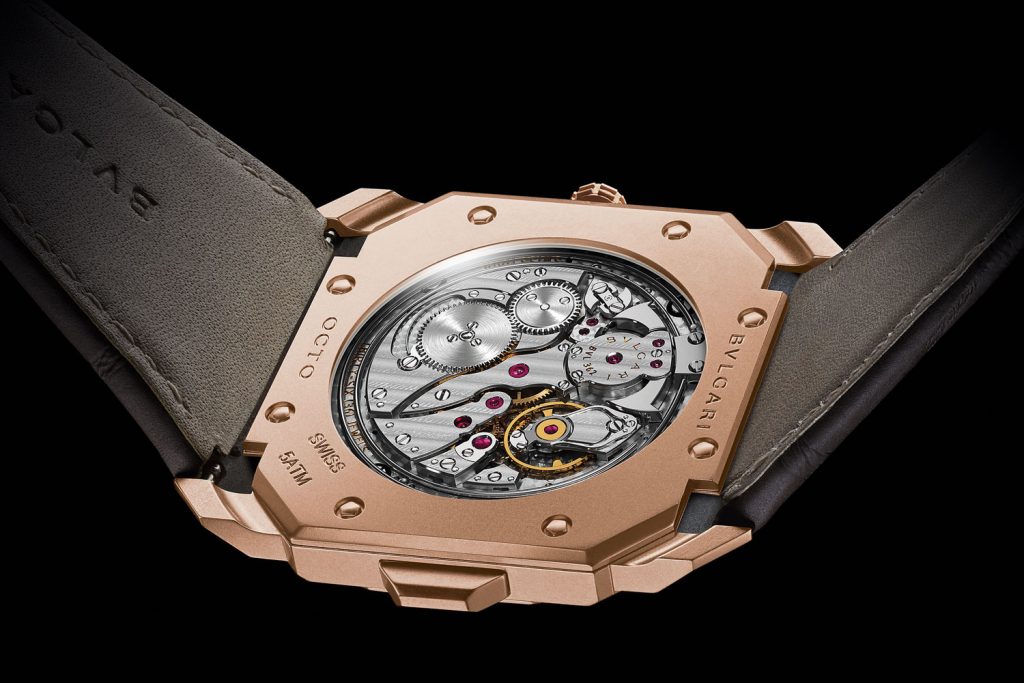
The BVL 362 caliber ultra-thin minute repeater, first appearing in the 2016 Octo Finissimo Minute Repeater
Bvlgari’s amazing BVL 362 minute repeater caliber would later appear in an even more stealthy carbon CTP (carbon thin ply) and PEEK (polyether ether ketone) case featuring a carbon-fiber dial replete with the complication’s signature skeletonization. And then this year, for the first time in a precious metal version, namely sandblasted gold. Says Babin, “In each instance we had to readjust the movement to the particularities of the case. Titanium has very good but different resonance qualities from carbon fiber and, again, from gold. So each version requires its own research and development.”

The Octo Finissimo Minute Repeater returns this year in a sandblasted 18K rose gold case and dial, measuring just 6.90mm thin (Image © Revolution)
2017: Octo Finissimo Automatic
Bvlgari followed up the incredible minute repeater with another world record, now in the category of the automatic small seconds watch featuring a micro-rotor. And, perhaps just as importantly, introducing the world to Bvlgari’s now signature ultra-thin integrated bracelet. Launched in 2017, the Octo Finissmo Automatic and its BVL 138 movement would eventually supplant the manual-wind version, though I like to think that this makes the manual-wind, special-edition Octo Finissimo Skeleton in titanium — like that on the minute repeater — made in just 50 examples for Revolution that much more collectible. Says Babin, “We moved to the micro-rotor automatic movement because we knew from our clients that this was a desired added touch of practicality. Yet we managed to achieve this without adding a single micron in the thickness to the movement going from manual to automatic, which I consider as great an achievement as any of our complications.”
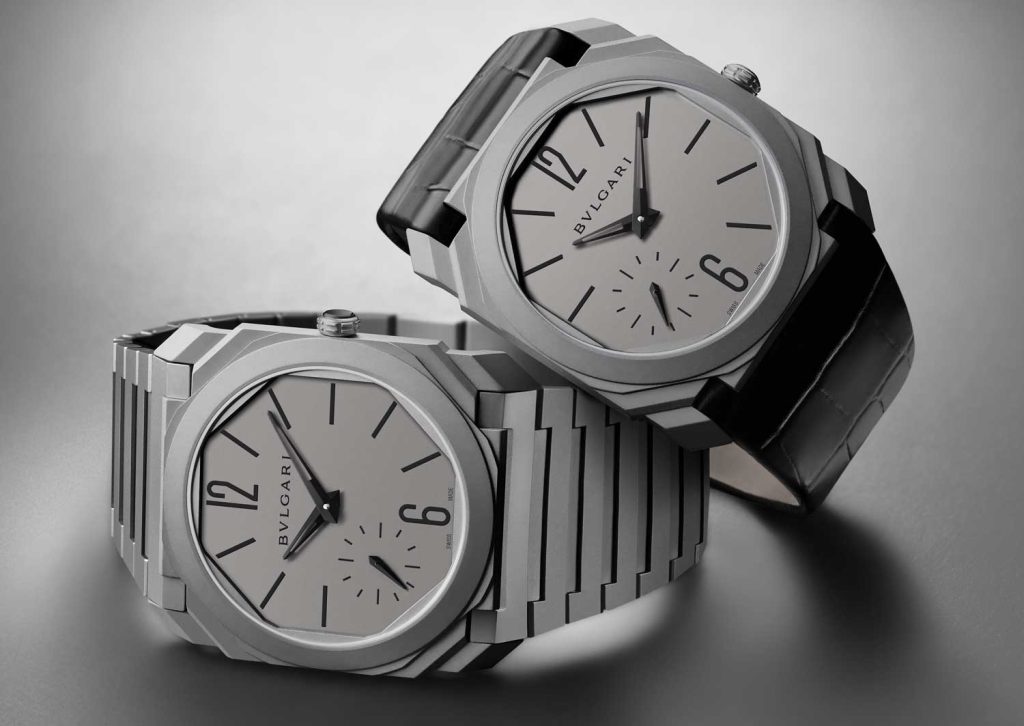
40mm sandblasted titanium case at only 5.15mm thickness of the Octo Finissimo Automatic launched in 2017, seen here on a titanium bracelet with folding clasp and black alligator leather with titanium pin buckle

The Octo Finissimo Automatic sandblasted rhodium plated steel (left), titanium (middle) and sandblasted rose gold (right)
Following the initial launch of the titanium automatic Octo Finissimo in 2017, in 2018 the watches launched in two more versions: a sandblasted rose gold version and a bright rhodium-treated steel version, each stunning in its own right. However, what made each watch particularly groundbreaking was that it was accompanied by the industry’s first truly advanced integrated metal bracelet. Compare a vintage Nautilus 3700 watch head to its bracelet and you understand that the two parts are made by different manufactures. And as beloved as the quirky Gay Frères bracelets are, they are never quite equal to the watch. Says Buonamassa, “The idea was that if we had spent all this tremendous investment and energy into creating a truly groundbreaking watch, then we absolutely had to create an equally groundbreaking bracelet.”
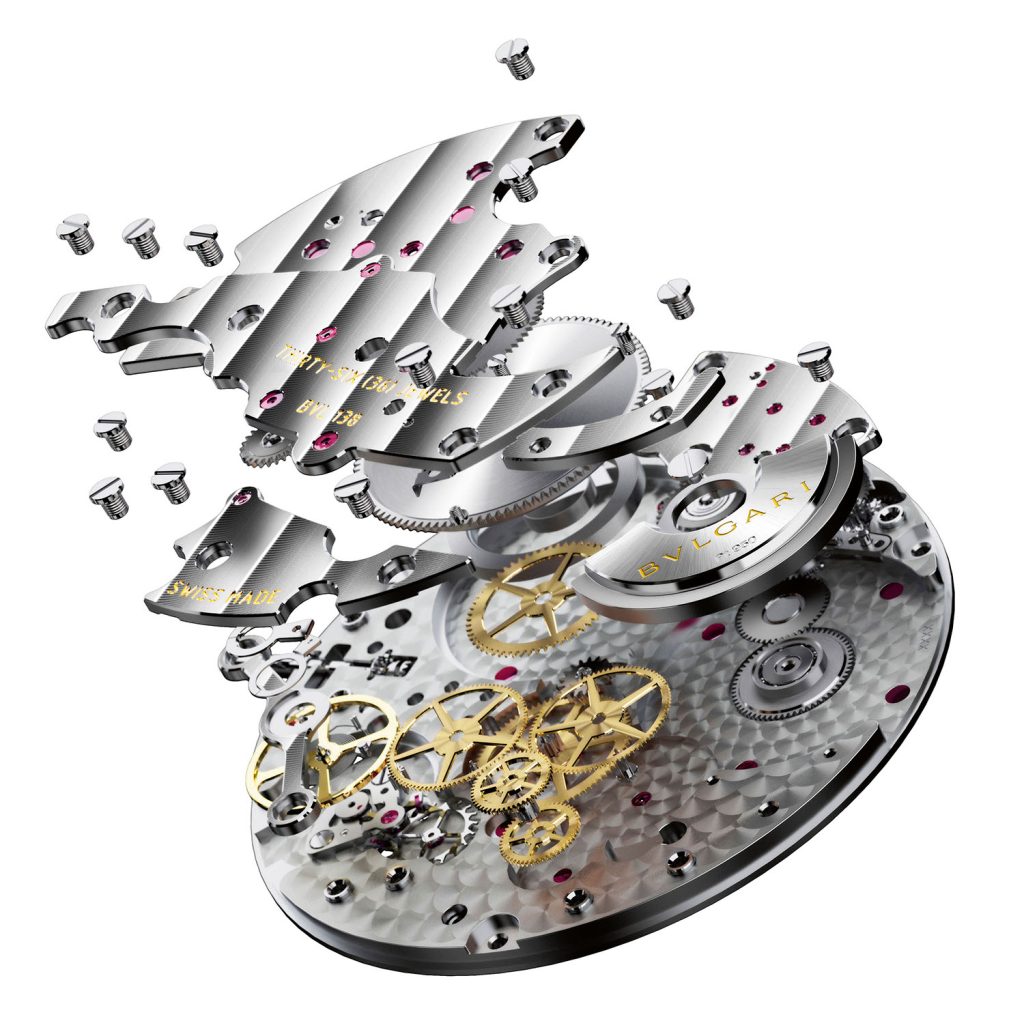
Bvlgari’s BVL 128 and 138 calibers bear individual bridges that do away with the need for a top plate or bridges, which also allows the balance to sit in line with the
gear train, rather than over it. The design, originated by Jean-Antoine Lépine, adds greater stability to an ultra-thin movement
Not only does the Octo Finissimo bracelet complement the model with its combination of muscular design when viewed from the front, yet extraordinarily slender profile when viewed from the side, it is also incredibly comfortable. Says Babin, “This is down to the incredible clasp that Fabrizio designed that is fully integrated and that you barely even feel is there. Again you see that at Bvlgari, it’s always technical innovation serving the needs of aesthetics.”
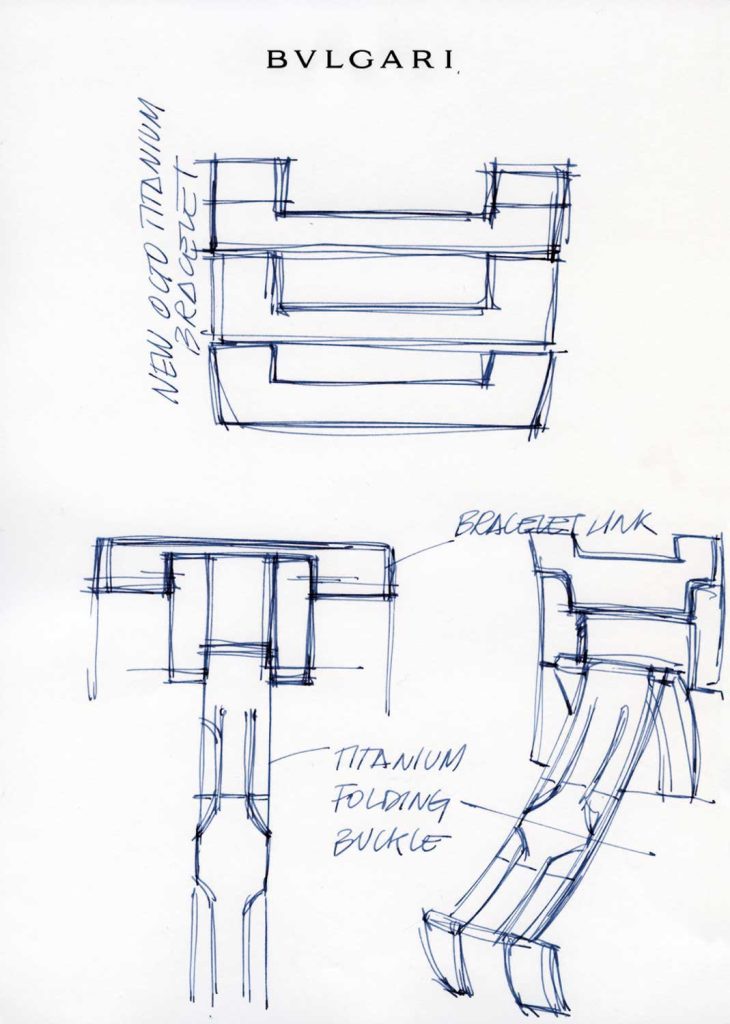
Drawings showing the conception of the Octo Finissimo's bracelet
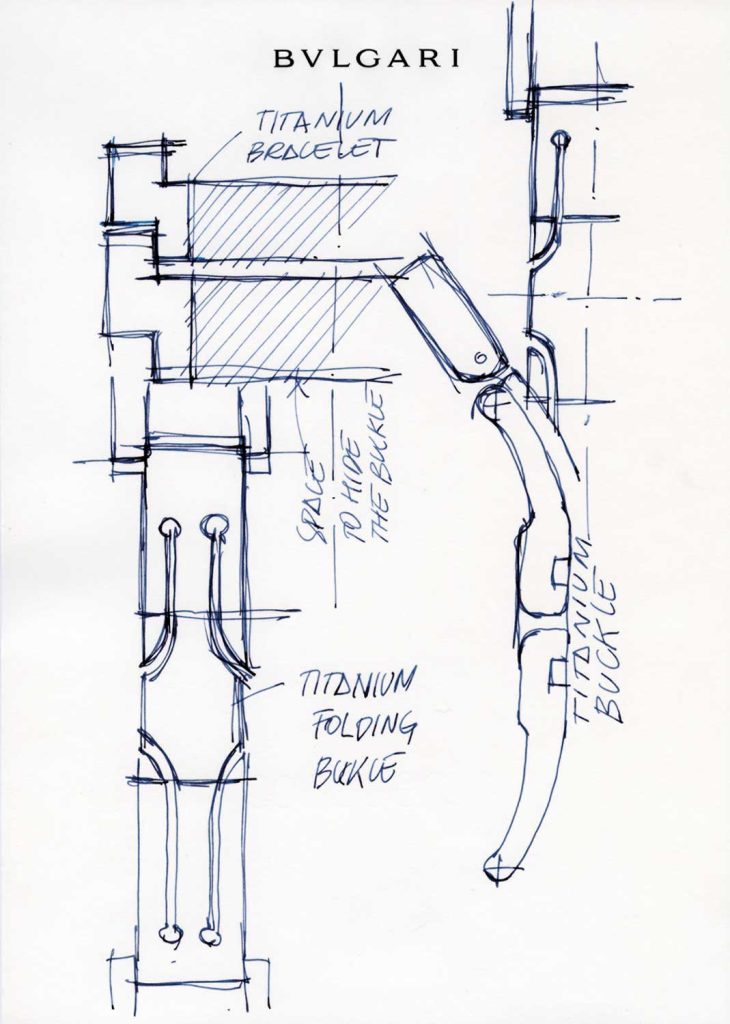
Drawings showing the conception of the Octo Finissimo's bracelet clasp
2018: Octo Finissimo Tourbillon Automatic
But there was another model in the Octo Finissmo family, which like the minute repeater, established Bvlgari as an innovator in the high-complication segment, and that was the Octo Finissimo Tourbillon Automatic. Says Babin, “The watch [the manual-wind version of the Octo Finissimo Tourbillon] also set a record as the world’s thinnest at its launch in 2014 — it was launched beside the petite seconds manual wind. You should understand that, at Bvlgari, we do not pursue these world records for their own sake. At the early stage of development of the Octo Finissimo range, we realized that we were already at such a thin profile that it encouraged us to really explore what we were capable of in the ultra-thin category. And this resulted in the world records for the manual wind, the automatic, the repeater, the tourbillon and later the chronograph. I suppose part of this comes from my past as the CEO of TAG Heuer for many years. That was a brand that was purely about performance and precision, and so this became part of who I am. It would not be possible for me to create a watch that was aesthetically compelling but that did not also have this performance credibility. On the other hand, I think the world records as well as the many prizes we have received for our watches, from the likes of Revolution and the Geneva Grand Prix, are great for the morale at our manufacture.”
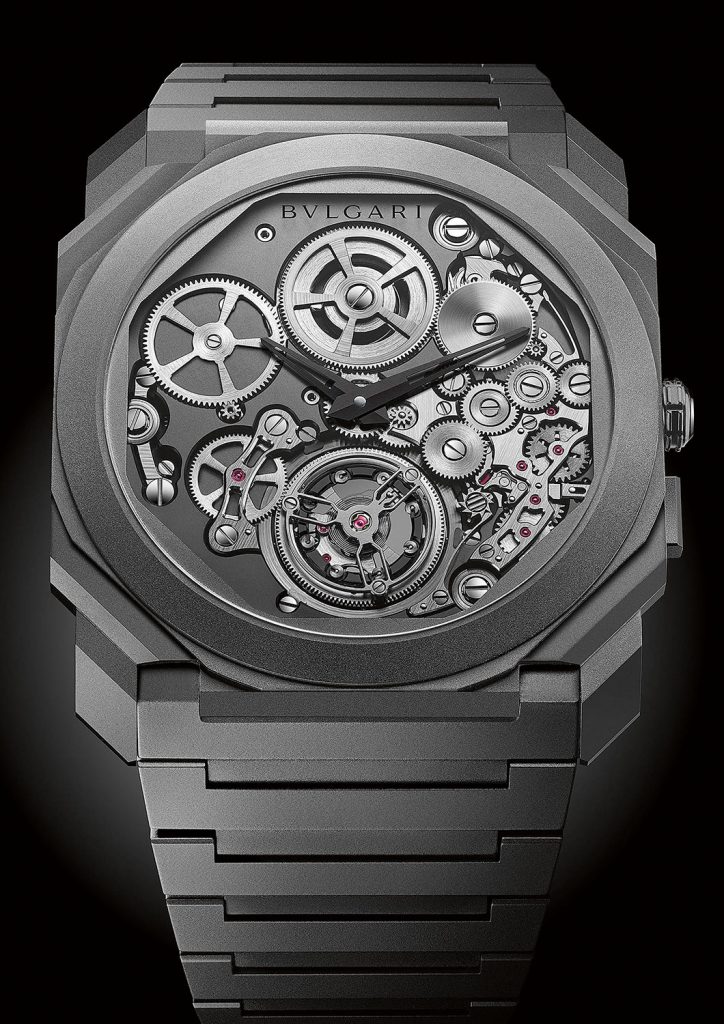
The Octo Finissimo Tourbillon Automatic with a skeleton movement and
peripheral winding mechanism
Fabrizio Buonamassa adds, “The automatic tourbillon is a watch that really shows off the technical side of Bvlgari. Here you have a flying tourbillon that is resting on ball bearings. It is a flying tourbillon, meaning that there is no visible bridge, giving you a full unobstructed view of the one-minute tourbillon and the oscillator beating inside it.”

The Octo Finissimo Tourbillon Automatic in sandblasted titanium
The first version of the flying tourbillon in the Octo Finissimo range dates to 2014. It was a stunning classic model with a solid black dial, with a tourbillon appearing at six o’clock. But in 2018, Bvlgari also offered an automatic version, with a stunning openworked version in grade 5 titanium with, of course, the brand’s signature ultra-thin titanium bracelet. This is a watch that I consider to be one of the most beautiful creations of the last decade. What is particularly beautiful about the Octo Finissimo Tourbillon Automatic, to me, is how power is retained in a skeletonized barrel at 12 o’clock. Along the right side of the BVL 288 movement, you see how power from the crown is transmitted to the barrel. You can actually just look at the state of wind of the mainspring for an idea of the watch’s power reserve. From there, you can see how that power is transmitted to a compact gear along the left side of the movement to power the perimeter of the tourbillon cage.
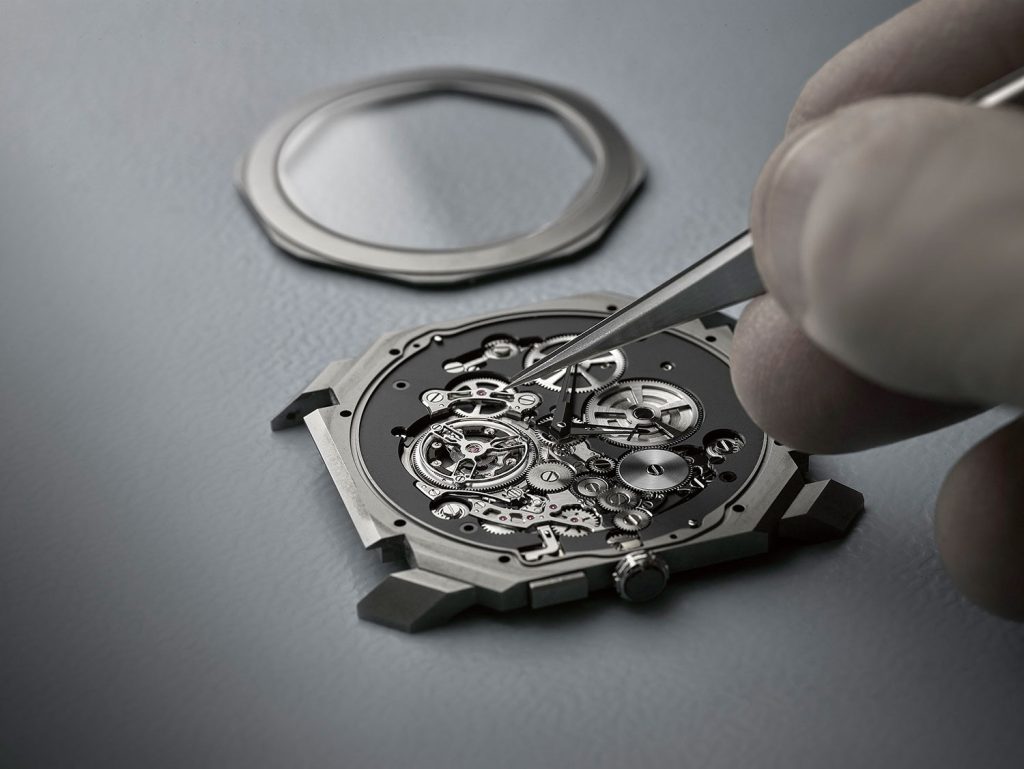
The caliber 288 has individual bridges for the moving parts of the gear train, enhancing its shock resistance
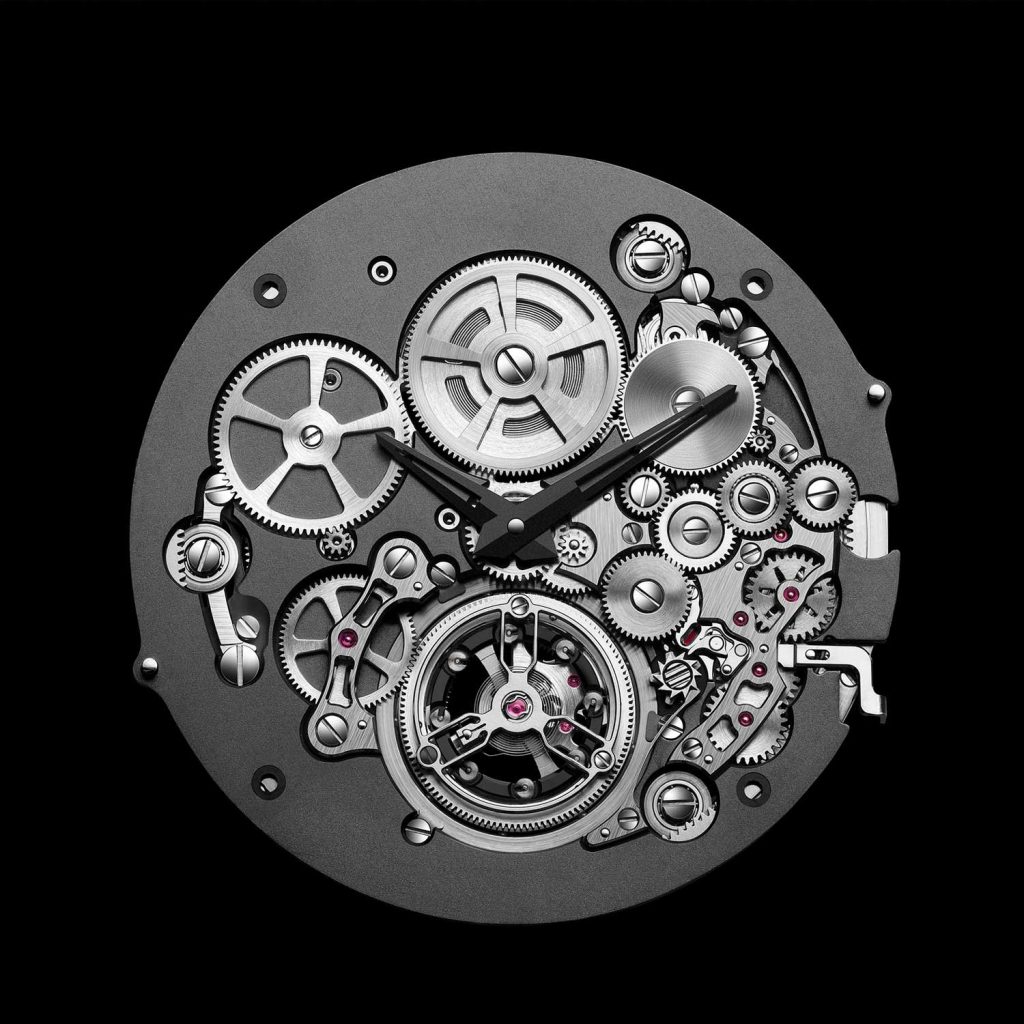
The Bvlgari BVL 228 Automatic Tourbillon movement seen from the front
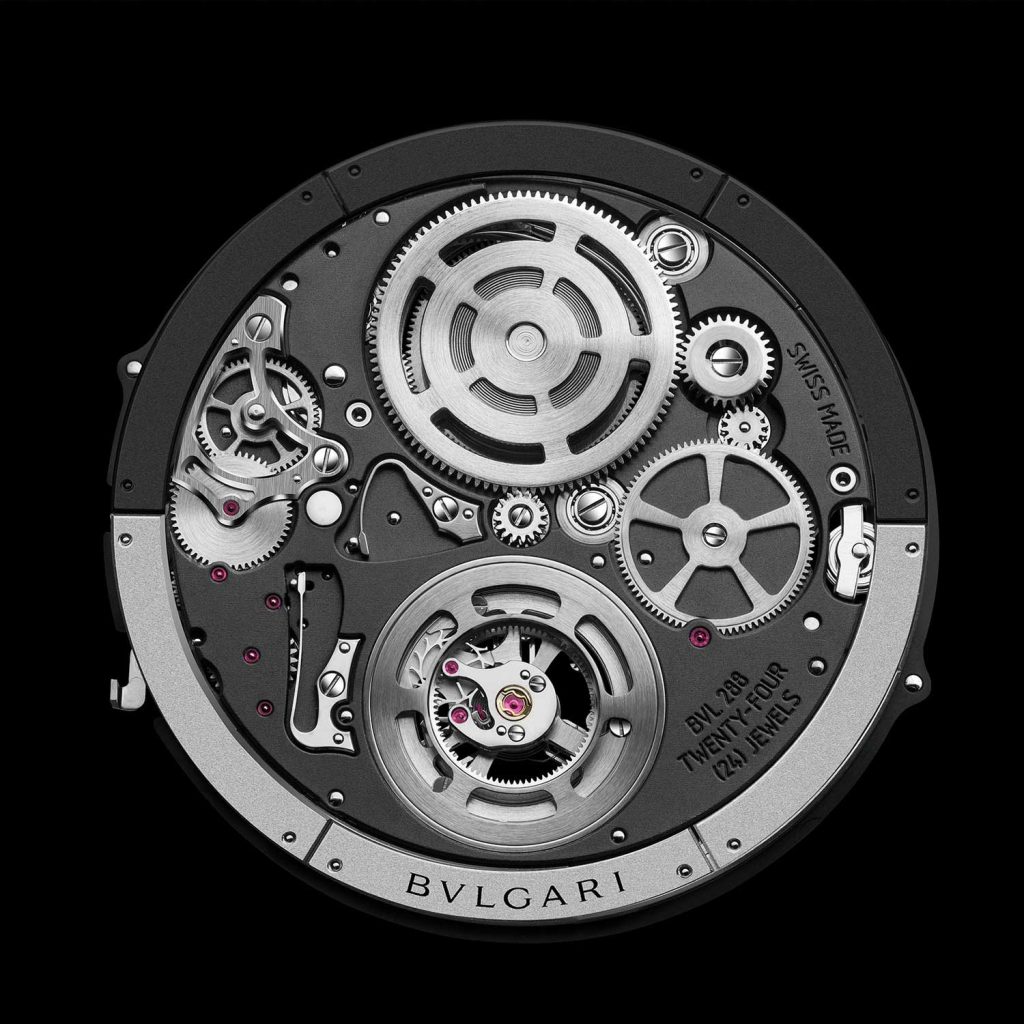
The Bvlgari BVL 228 Automatic Tourbillon movement seen from the back with the peripheral rotor visible
What you don’t see from the front of the watch, however, is the peripheral mass that powers the movement’s automatic-winding function. Also, if you compare the openworked titanium version to the manual-wind classic Octo Finissimo Tourbillon, you’ll see that even the tourbillon cage and balance wheel have been executed in a stealthy hue to keep the entire watch monochromatic. Says Babin, “There are few brands that would create a different finish on their balance wheel and tourbillon cage, simply to create a different visual identity from one version to the next of the same watch. But at Bvlgari, we don’t believe in compromise.” Bvlgari followed up the titanium version of this tourbillon last year with a stunning carbon CTP case.
2019: Octo Finissimo Chronograph GMT Automatic
It’s funny that the world went from having almost no in-house automatic chronographs with a prevailing reliance on the Zenith El Primero, the Valjoux 7750, the Dubois-Dépraz module or the Frédéric Piguet 1185 to almost everyone having an in-house chronograph. Much of this was made possible by the advent of CAD/CAM (computer aided design and manufacturing) and CNC (computer numerical control) machining. However, in every instance, regardless of which manufacture, the resulting movements — regardless of their technical fireworks, comprising column wheels and vertical clutches — are extremely thick. In a world that has suddenly reverted to more classic proportions, many of these manufactures find themselves caught out because their movements necessitate watches that are too thick for consumers’ tastes. So it was with a huge smile, a palpable sense of relief and absolute exuberance that the watch world greeted Bvlgari’s 2019 Octo Finissimo Chrono GMT. Powered by the caliber BVL 318 which is a scant 3.30mm in depth, the resulting 6.90mm-thin grade 5 titanium watch is a revelation on the wrist.
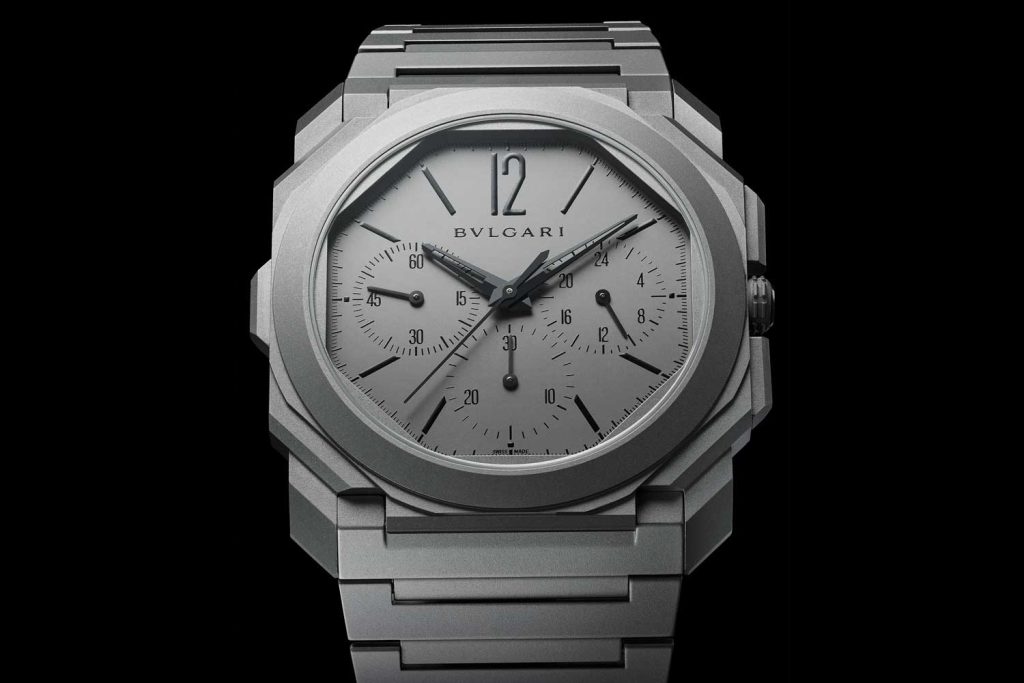
The 2019 Octo Finissimo Chronograph GMT Automatic in sandblasted titanium
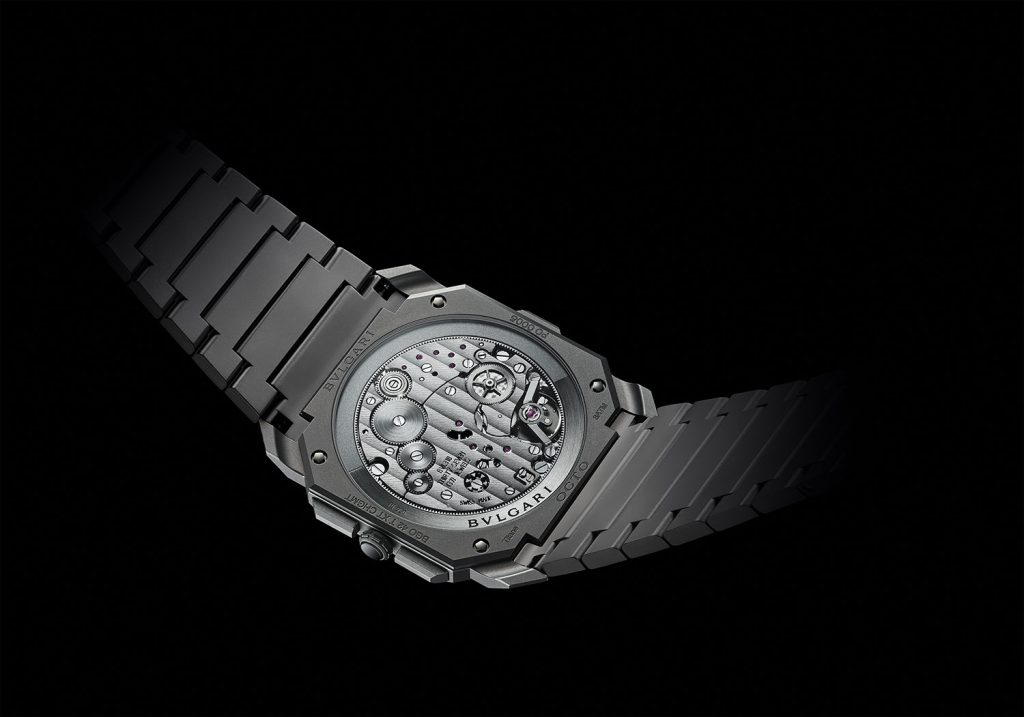
The caliber 318 is a horizontally coupled, column wheel controlled movement with peripheral winding and a second time zone function, a truly practical and sophisticated movement for today’s consumers
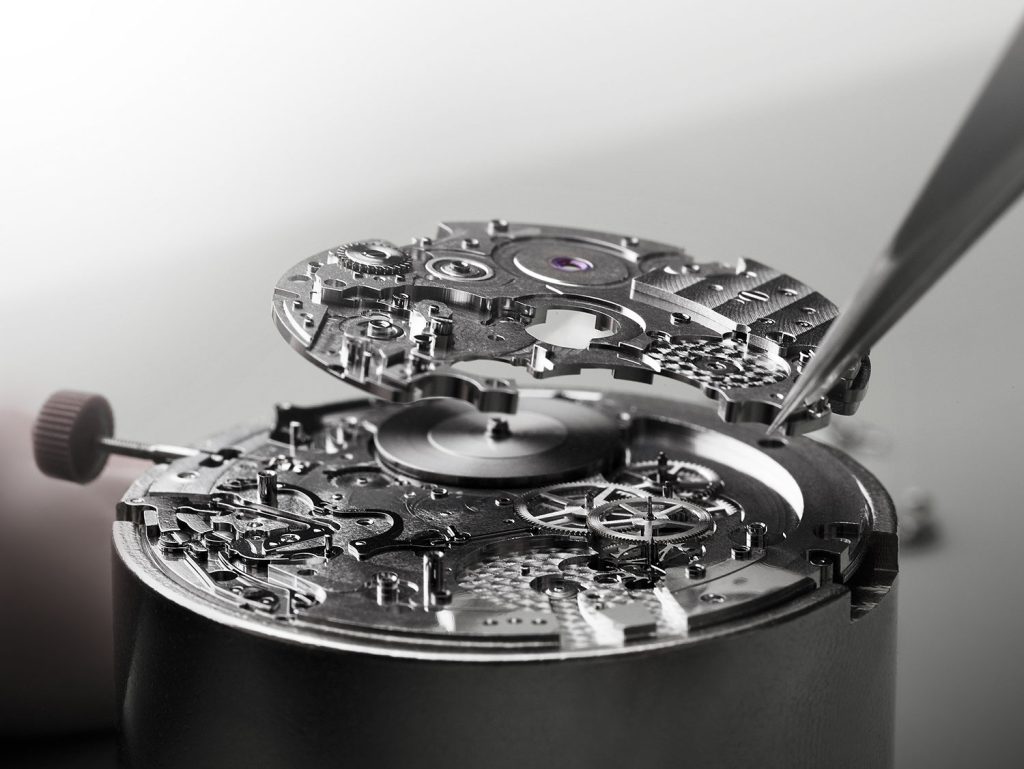
Assembling the BVL 318 caliber, one can see just how brilliantly the movement
is designed
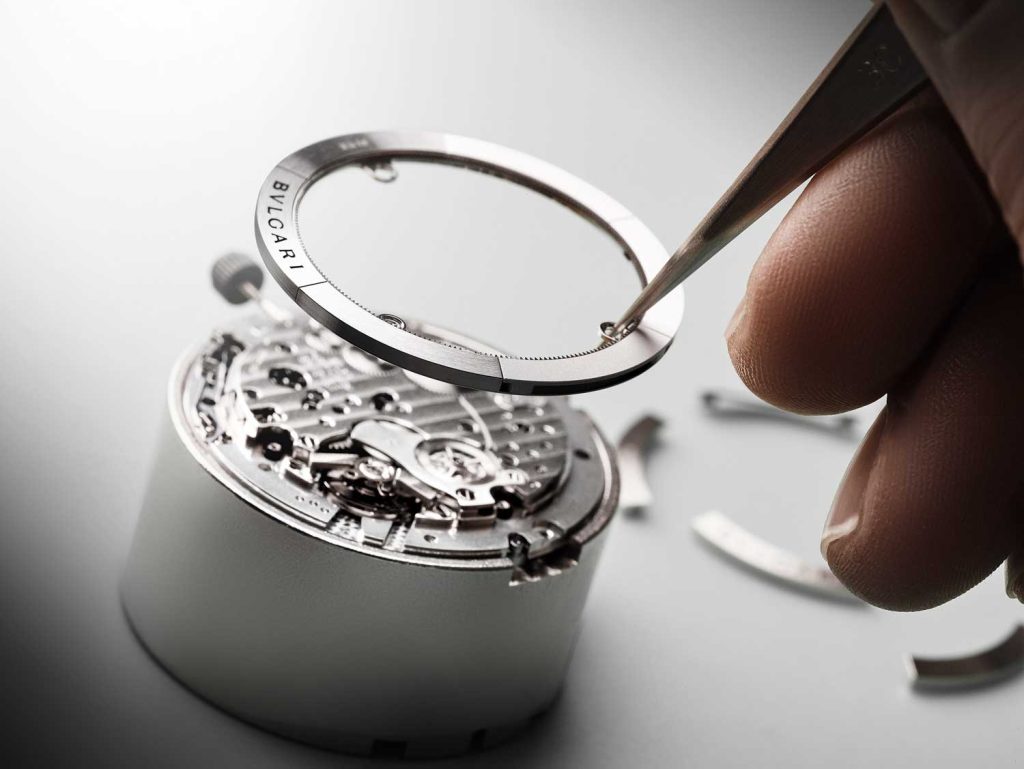
The BVL 318 caliber's peripheral rotor allows for the beautiful movement to remain visible from the caseback
It must be said that each time Bvlgari adds a complication to its arsenal, it does so with a seamless and perfect design integration of the new functions. This is certainly the case with the minute repeater that adds a single, barely noticeable yet totally functional push-piece to the side of the case. And that is certainly the case with the Octo Finissimo Chrono GMT. The chronograph pushers of the watch are so perfectly placed and integrated that, at first, you think that Bulgari has just added a subtle pair of crown guards. Ditto the push-piece on the left of the case that operates the super functional GMT indicator, which can be read off the 24-hour scale in the subdial at three o’clock. The rest of the dial offers supreme ease of use, with a continuous seconds indicator at nine o’clock and a 30-minute chrono totalizer at six o’clock. So what could possibly be a dream version of this chronograph? Well, I’m glad you asked. Because celebrating the 15th anniversary of Revolution, we’ve decided to make an exclusive 15-piece edition of the Octo Finissimo Chrono GMT.

The Octo Finissimo Chronograph GMT Automatic in sandblasted titanium (Image © Revolution)
2020: Bvlgari x Revolution Octo Finissimo Chrono GMT Automatic Limited Edition
Says Buonamassa, “I loved the idea that you proposed about making an ultimate tool version of this chrono, one that someone who loves performance and motorsport could actually use with great effect. So we decided to put a tachymeter on the bezel.” It’s true that there is a Zenith-powered, BVL 328 caliber Octo model, the Velocissimo, that features a tachymeter. But as Buonamassa explains, “Ah yes, but on the Octo Finissimo model, the bezel is so much thinner, and the tolerances so fine that it was a real challenge to print this.” Furthermore, the truly unique distinction of the Revolution edition is its status as the first fully luminous Octo Finissimo. Says Buonamassa, “For this I had to be a bit creative, because the hands and the indexes as you know are so fine that it was impossible to apply Super-LumiNova to them in the traditional way. In the end, we found a really cool solution.”
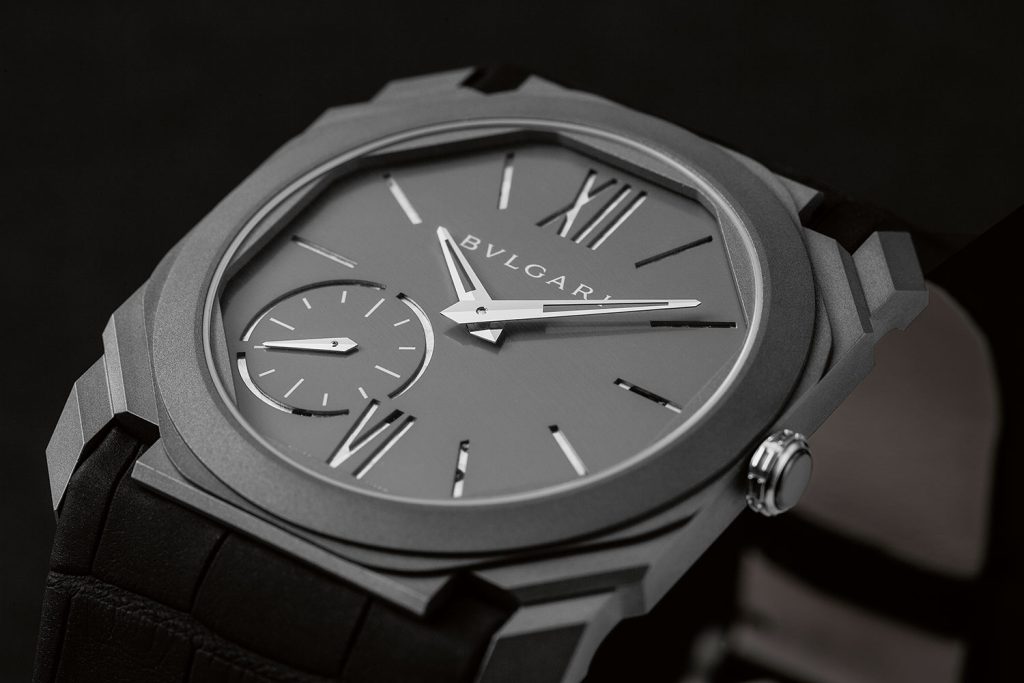
The 2016 Bulgari x Revolution Octo Finisimmo Limited Edition (Image © Revolution)
Says Jean-Christophe Babin, “We are very proud to collaborate with Revolution on this limited edition celebrating the magazine’s 15th anniversary. You are really innovators in the field. You took watch journalism which could be dry and made it fun, sexy and entertaining, while still keeping technical credibility. In addition, 15 years of great friendship and partnership is a great thing to celebrate.”
2020: Octo Finissimo Automatic Satin-Polished Steel
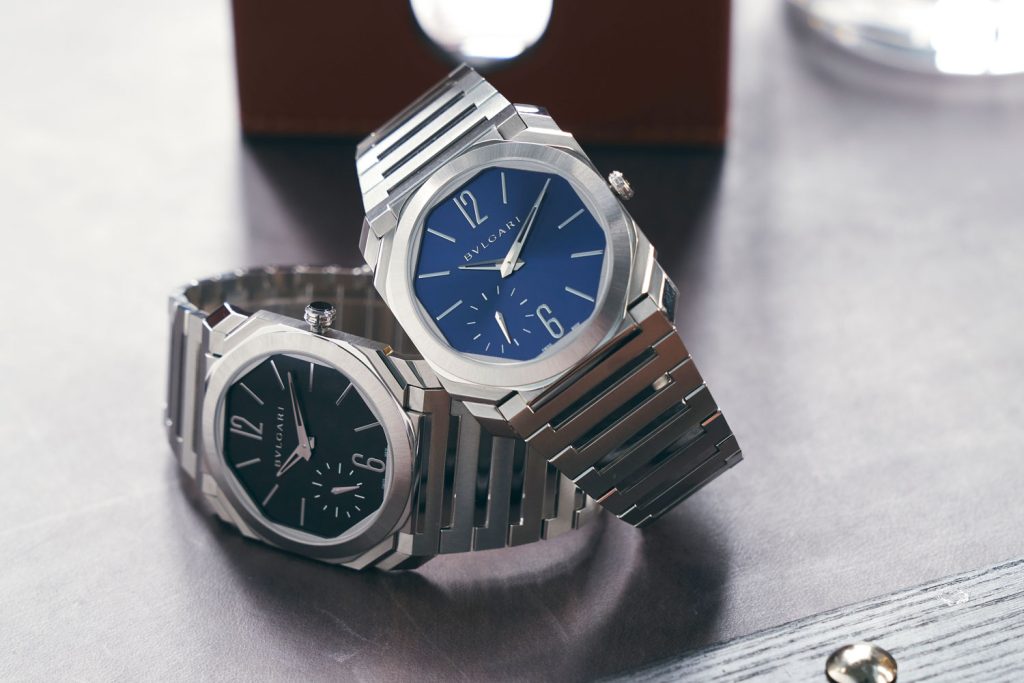
The new Octo Finissimo in satin polished steel are two of Bvlgari’s latest releases for the year, in a matte black dial (left) and a blue sunray finished dial (right) (Image © Revolution)
Looking back at its staggering number of world records and skyrocket-like trajectory in popularity and prominence, it is incredible that Bvlgari’s Octo Finissimo is only six years old. In that time, it has won innumerable accolades. These include the 2019 Grand Prix d’Horlogerie de Genève (GPHG) Chronograph Watch Prize; a double win in the 2017 GPHG for Men’s Watch with the Octo Finissimo Automatic and best Tourbillon and Escapement with the Octo Finissimo Tourbillon Skeleton; not to mention Revolution Awards in 2014 and from 2016 till 2019 for their world-record-setting watches. But of all that he has achieved, Jean-Christophe Babin is perhaps most excited about his latest and apparently simplest models. These are two new steel Octo Finissimo models, the first with a black dial and the second with a rich blue dial.
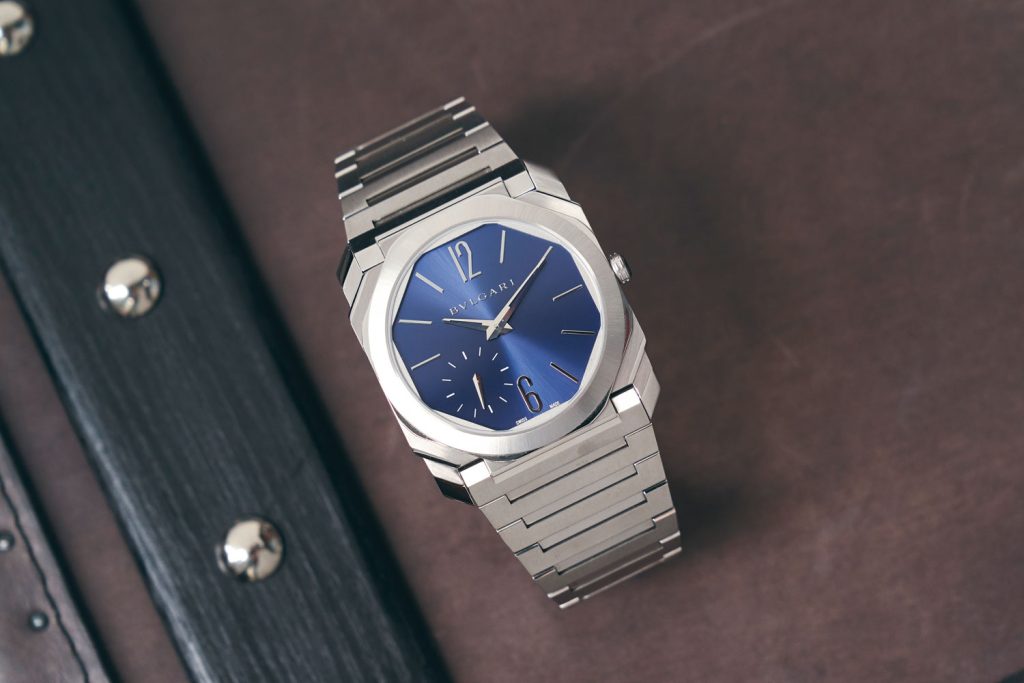
The Octo Finissimo Automatic in satin polished steel with blue dial (Image © Revolution)
As opposed to the previous rhodium-treated, sandblasted versions, these new watches feature a charming use of brushed and polished finishes. They have also been increased slightly in thickness to 6mm and now feature a screw-down crown and a corresponding 100-meter water resistance. What I love about both versions of these watches is that they are the first to tread boldly into Royal Oak and Nautilus territory and, at US$12,000 retail, offer up some very serious competition. But I also love the fact that Bvlgari avoided doing this for a full six years, first setting five world records and truly cementing their status as a modern-day icon before playing this card.

The Octo Finissimo in satin polished steel with blue sunray finished dial (Image © Revolution)
Says Babin, “For me, the complicated watches are like supercars. These are watches that are more rare and at a different price category. I feel it is only at this point with the launch of these two new steel models that we are actually moving into iconic status. Because now the watch is much more accessible to a greater number of people. The steel models are Bvlgari’s GT [grand tourer] models as opposed to the minute repeater or tourbillon which are our supercar models, and I feel now that with the Octo Finissimo on many more wrists, this opens up a new era for us. I am incredibly proud of what the team has achieved over the last six years.”
Finally, with Bvlgari being an iconic Roman brand, I could not finish this article without remarking on their efforts to combat the COVID-19 pandemic that is sweeping the world. Says Jean-Christophe Babin, “We are an Italian brand and we were profoundly moved to see how badly the pandemic had affected Italy. We learned of a hospital, Lazzaro Spallanzani, that was doing incredible work. There are three researchers there — Maria Rosaria Capobianchi, Francesca Colavita and Concetta Castilletti — who managed to successfully isolate the virus in under 48 hours. But they were lacking a key piece of equipment — a 3D imaging microscope that would allow them to take the next step in combating the virus.

CEO Jean-Christophe Babin presenting the 3D imaging microscope that Bvlgari aided
the Lazzaro Spallanzani hospital in acquiring
“We felt that we should step in and supply them with this. I know that this is just a small effort in what is a global crisis. But even at a time when we are facing a great financial challenge, we understand we must do everything we can. We have a fragrance factory outside of Milan. At that factory, we have found a way to manufacture [with fragrance manufacturing partner ICR] a new hand sanitizer which Italy is badly in need of. We now have the capacity to manufacture up to 6,000 bottles a day and we are gearing up so that we can supply that to all the badly affected areas.
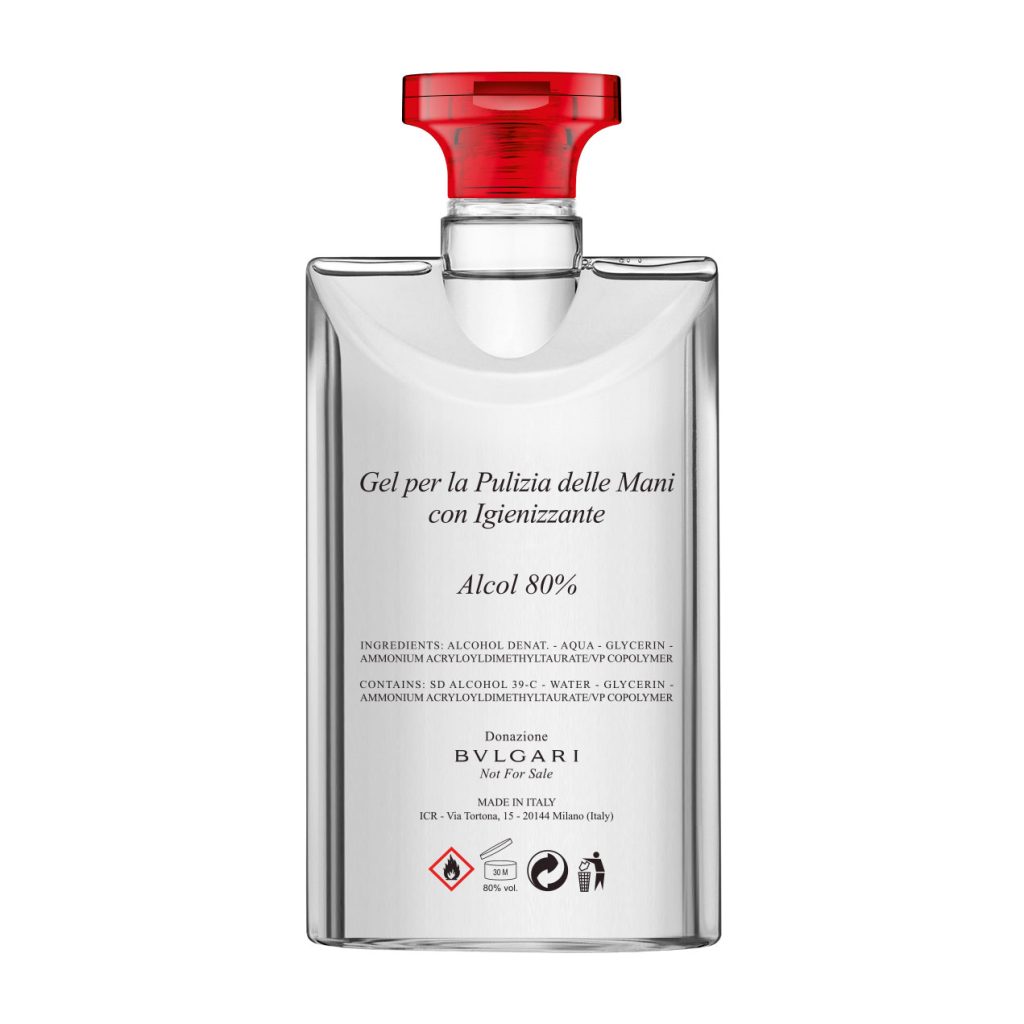
Bvlgari’s hand sanitizer that its fragrance manufacturing partner, ICR, has developed to supply affected regions
“We love Italy and we know that Italy is a land of great art, great beauty, great resilience and great humanity. We will, of course, get through this terrible time together by helping each other and inspiring the best from each other.” And with that, we understand that Bvlgari is a brand that is innovating not just in watches and jewelry, not just in trade shows and communication, but also thanks to its leader Jean-Christophe Babin, innovating where it counts most, in the effort to help other people.
Timeline of Records and Accolades
[vc_column_inner width=”1/3″][td_block_text_with_title custom_title=”2014: OCTO FINISSIMO MECHANICAL HAND-WOUND & OCTO FINISSIMO TOURBILLON”]In 2014, Bvlgari unveiled the first Octo Finissimos, with an ultrathin hand-wound movement that was just 2.23 mm thick, housed in a platinum case. It also presented a tourbillon caliber, that measured just 1.95mm thin. The Octo Finissimo Tourbillon won a Revolution award for Best Concept Watch that year.[/td_block_text_with_title][vc_column_inner width=”1/3″]
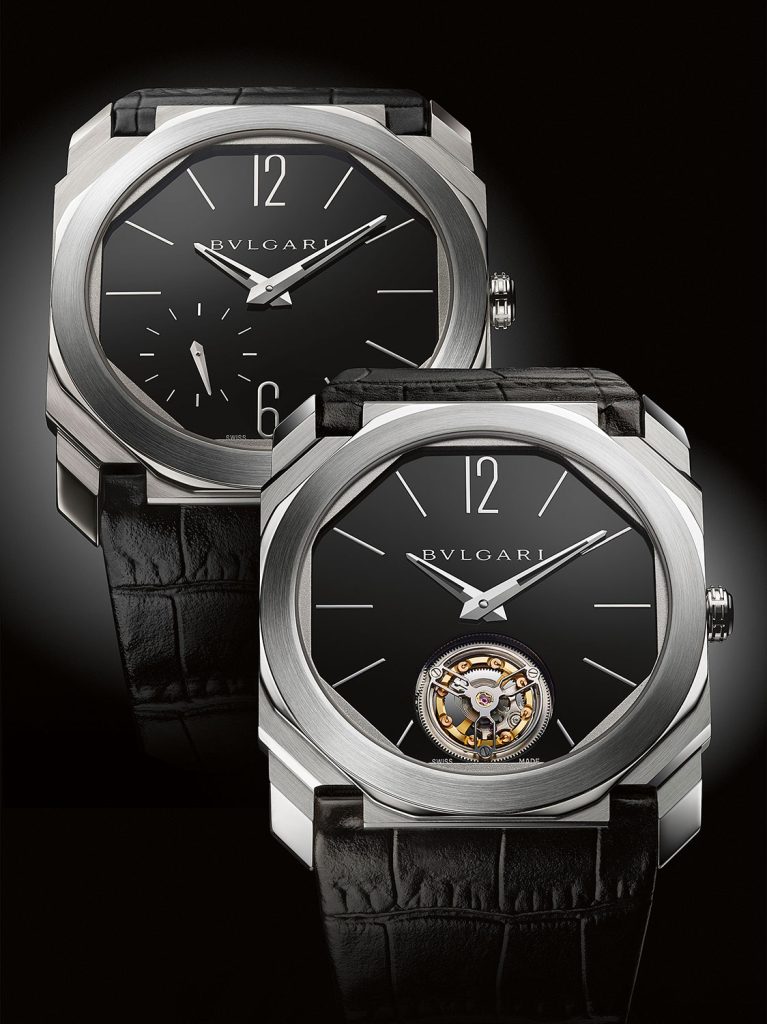
2014: Octo Finissimo Mechanical Hand-Wound
[vc_column_inner width=”1/3″][vc_column_inner width=”1/3″][td_block_text_with_title custom_title=”2016: OCTO FINISSIMO MINUTE REPEATER”]Bvlgari unveiled the Octo Finissimo Minute Repeater in a titanium case, featuring the ultra-thin 3.12mm BVL 362 movement. It was a bold design, featuring cut-out dial markers that enabled the sound to pass through from the back of the movement, thus amplifying the volume of the chimes. The watch won Revolution’s Revolutionary Watch 2016 award.[/td_block_text_with_title][vc_column_inner width=”1/3″]

2016: Octo Finissimo Minute Repeater
[vc_column_inner width=”1/3″][vc_column_inner width=”1/3″][td_block_text_with_title custom_title=”2017: OCTO FINISSIMO AUTOMATIC”]An automatic version of the time-only Octo Finissimo arrived with the micro-rotor powered BVL 138 caliber, at the same 2.23mm measurment as its manual wind predecessor. It took home the Best Men’s Watch prize at the Revolution Awards 2017 and at the 2017 GPHG, and a skeletonized version of the Octo Finissimo Tourbillon also won Best Tourbillon at the GPHG.[/td_block_text_with_title][vc_column_inner width=”1/3″]
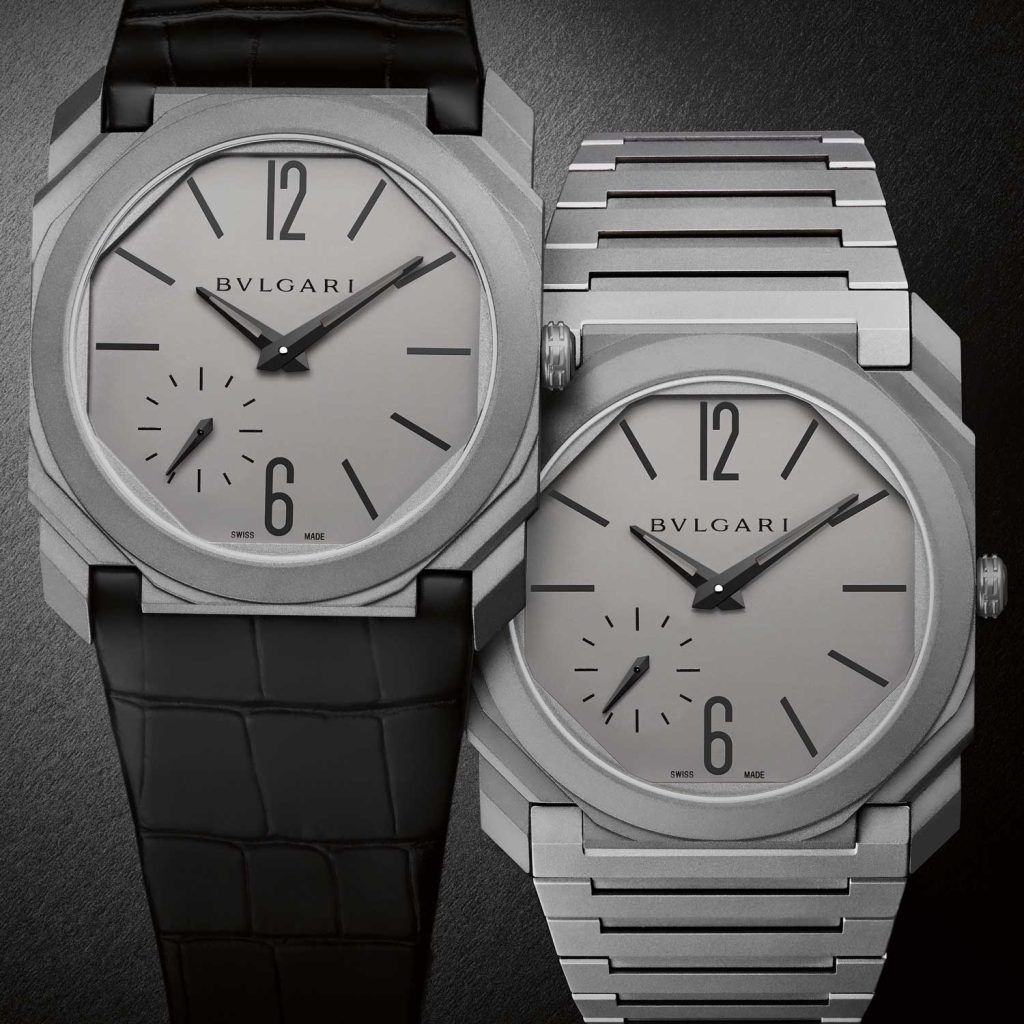
2017: Octo Finissimo Automatic
[vc_column_inner width=”1/3″][vc_column_inner width=”1/3″][td_block_text_with_title custom_title=”2018: OCTO FINISSIMO TOURBILLON AUTOMATIC”]An automatic version of the tourbillon caliber, the BVL 288, introduced a bold new design for Bvlgari — a peripheral winding rotor, which allowed one to view the movement in its entirety with the benefit of automatic winding. The watch won the Technical Achievement award in our Revolution Awards 2018.[/td_block_text_with_title][vc_column_inner width=”1/3″]
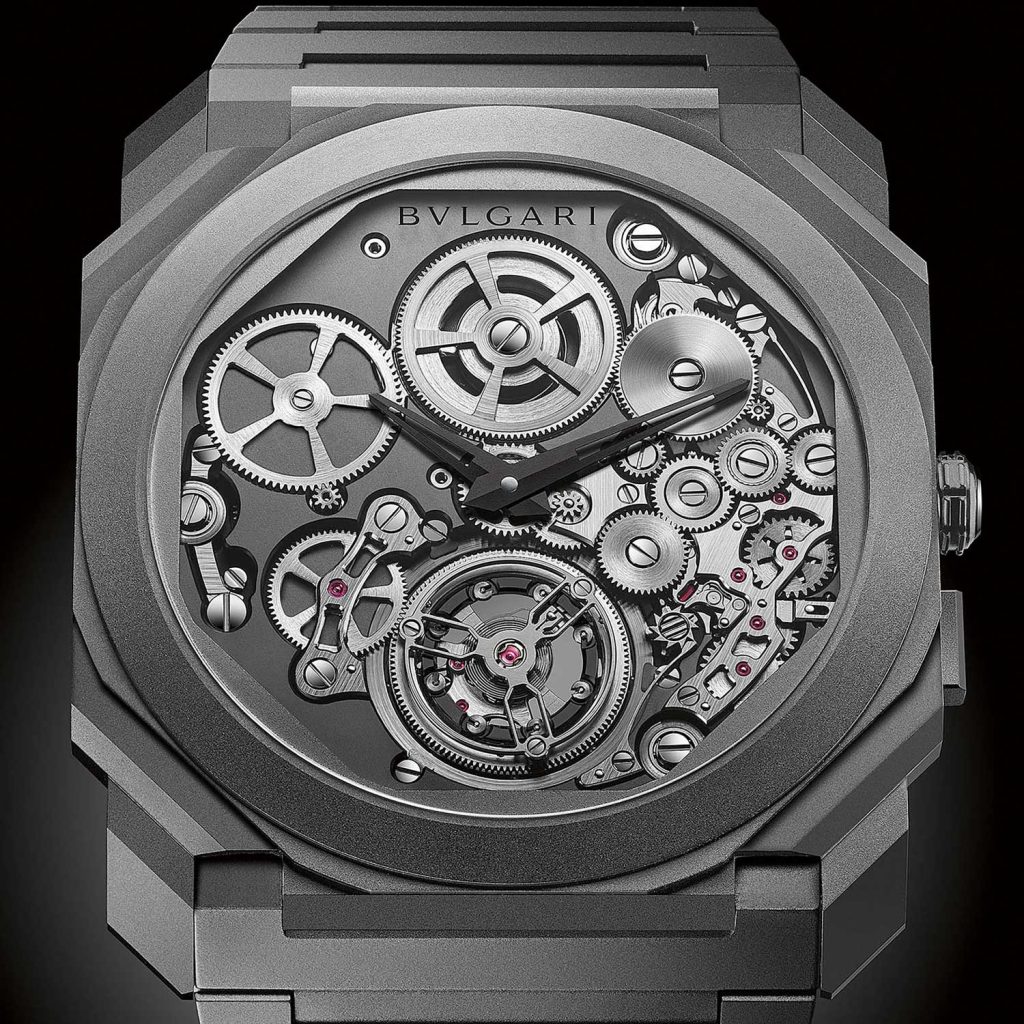
2018: Octo Finissimo Tourbillon Automatic
[vc_column_inner width=”1/3″][vc_column_inner width=”1/3″][td_block_text_with_title custom_title=”2019: OCTO FINISSIMO CHRONOGRAPH GMT AUTOMATIC”]The Chrono GMT Automatic is one of the most impressive Bvlgari Octo Finissimos around, featuring a modern horizontally coupled, column wheel controlled chronograph with peripheral winding and a second time zone function, all within a 3.30mm thin movement. It took home the Best Chronograph prize at the 2019 GPHG, and Revolution’s Technical Star.[/td_block_text_with_title][vc_column_inner width=”1/3″]
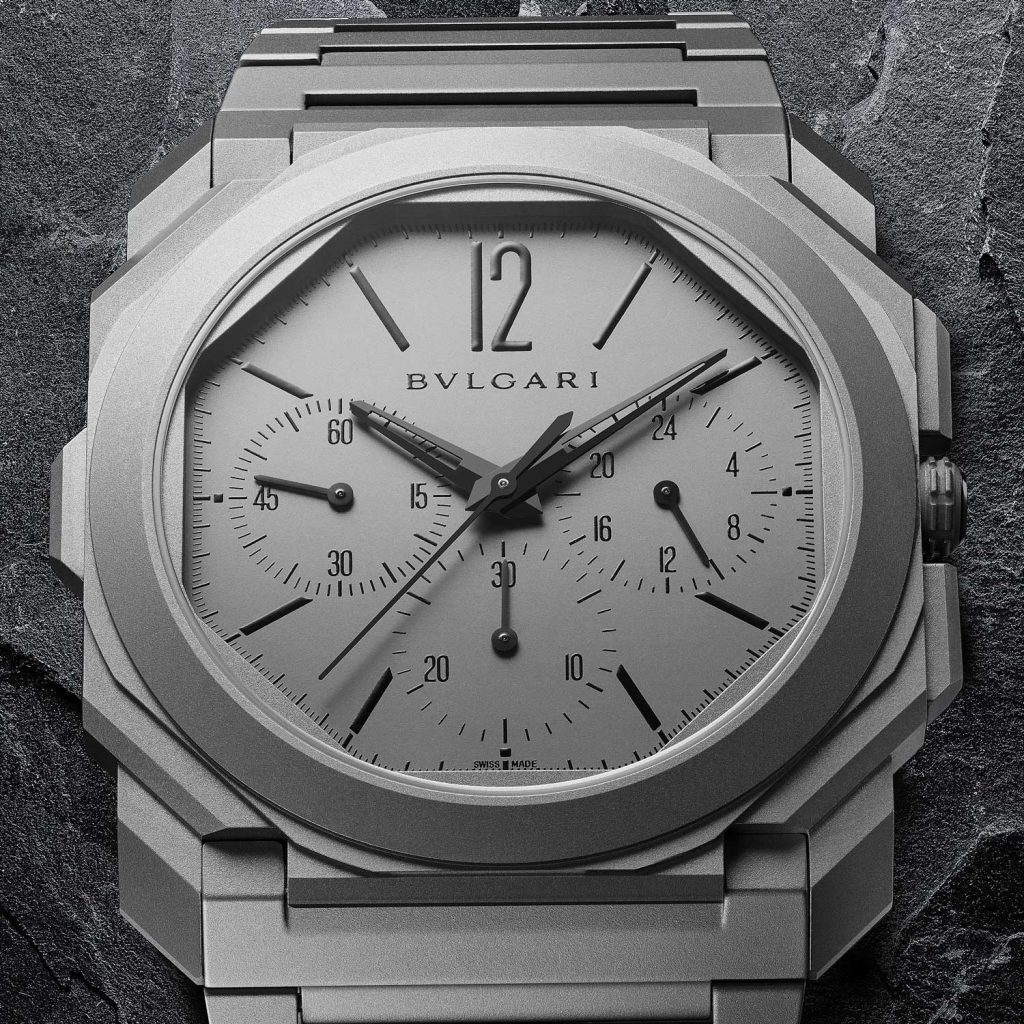
2019: Octo Finissimo Chronograph GMT Automatic
[vc_column_inner width=”1/3″][vc_column_inner width=”1/3″][td_block_text_with_title custom_title=”2020: OCTO FINISSIMO AUTOMATIC SATIN-POLISHED STEEL”]The steel-cased, satin-polished version of the Octo Finissimo Automatic has earned plaudits from across all segments of the watchmaking industry. Not only is it a true modern sports chic watch with an ultra-thin design, it also has a water resistance of 100 meters, made possible by increasing the case just slightly to 6mm and adding a screw-down crown.[/td_block_text_with_title][vc_column_inner width=”1/3″]
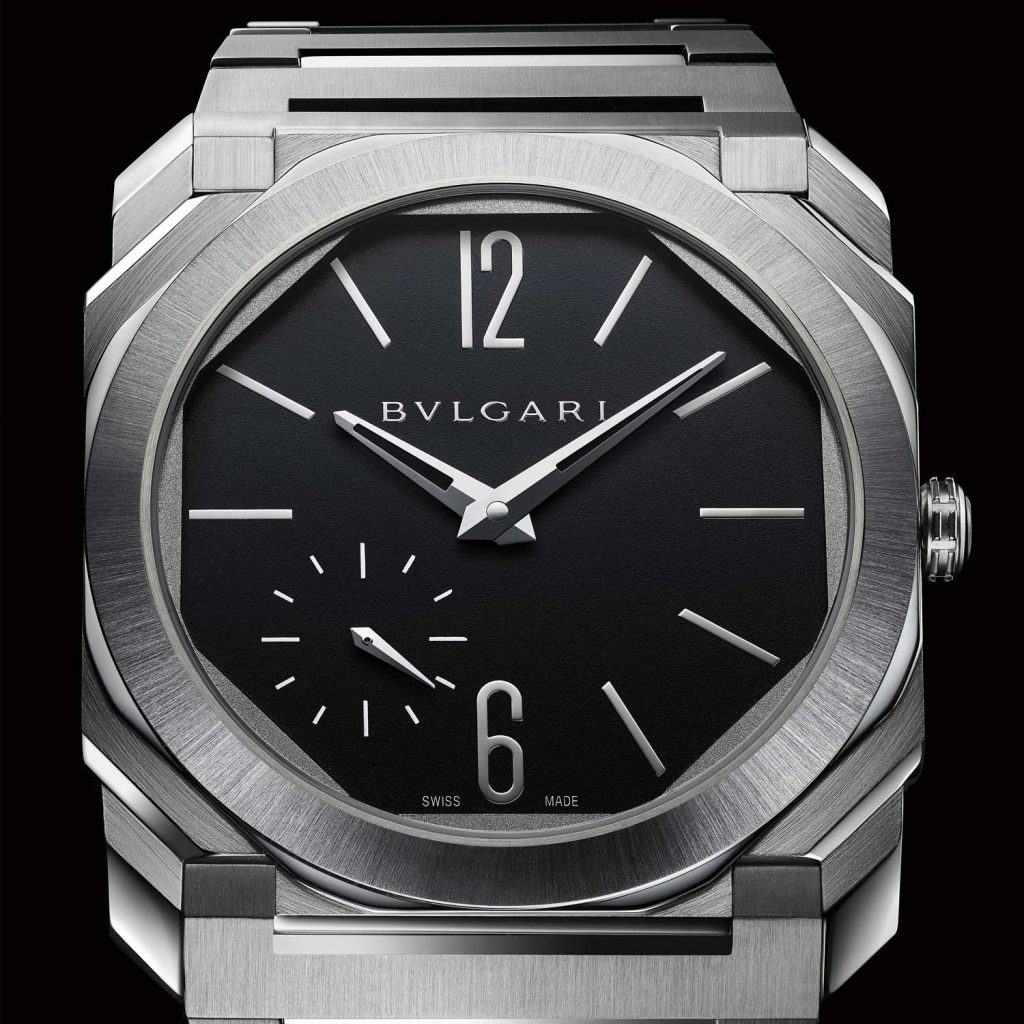
2020: Octo Finissimo Automatic Satin-Polished Steel
[vc_column_inner width=”1/3″]



































